MENU
MENU
CHAMART sells various Japanese tea certified as Organic JAS (Japanese Agricultural Standards) overseas as a wholesaler.
Most of CHAMART’s teas are cultivated using CHAGUSABA farming method, recognized as a Globally Important Agricultural Heritage System (GIAHS) by the Food and Agriculture Organization of the United Nations (FAO) in 2013.
The method maintains the environment and biodiversity.
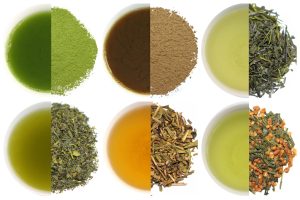
If you are a tea professional such as a tea buyer, owner/staff of a tea shop, cafe or restaurant, etc., who is interested in JAPANESE TEAs, please contact us.
CHAMART will introduce the following Japaneses Teas from Shizuoka, Japan recognized as Organic JAS at the trade fairs.
You can taste different types of Teass and receive free samples at CHAMART’s stand if you are thinking about importing them.
CHAMART introduces various examples of drink and food using Japanese Teass at “How to use TEA” on this website.

Matcha from Kakegawa
ORGANIC JAS
CHAGUSABA
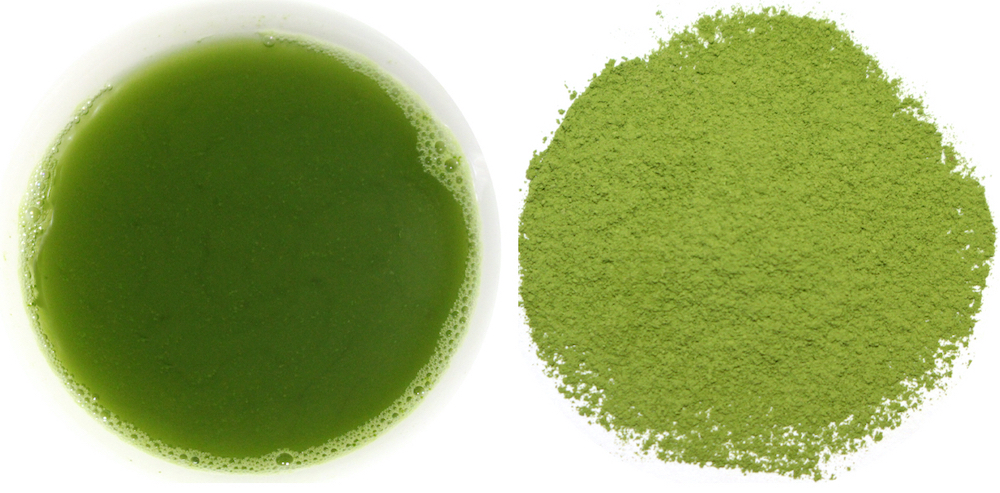
Type of tea
Matcha (Special high-quality green tea powder)
Production place
Kakegawa City, Shizuoka Prefecture, Japan
Producers of tea
A family-run tea garden that manages the production of tea from cultivation through processing.
Leaf (particle size)
Powder 100 mesh pass (10 µm)
Color of brewed tea
Light green
Flavor
Rich matcha aroma (a slightly salty, sea breeze aroma), smooth, mild, bitter taste
Other
Matcha is NOT powdered sencha (steamed green tea). The ingredient of Matcha is tencha, which is a green tea cultivated and processed by a special method. The tea leaves for tencha are covered by straw mats or black cloth for 3 weeks or more to block the sunlight before plucking. The leaves for tencha are steamed, but not rolled like sencha. The leaves keep their bright green color when they are not rolled, creating matcha’s color.

The tea plants are covered with man-made black cloth
Blocking the sunlight increases the amount of theanine, a component of umami and sweetness, and decreases catechin, a component of bitterness and astringency. Additionally, theanine has relaxing effects.
It takes more processes and time compared to making sencha.
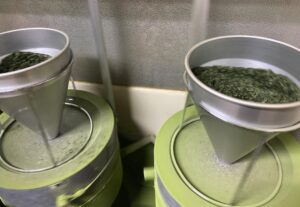
Organic farming (certified Organic JAS *)
○
CHAGUSABA farming method *
○
The tea is cultivated using the CHAGUSABA farming method in GIAHS (Globally Important Agricultural Heritage Systems) recognized areas.
*The CHAGUSABA farming method is NOT an organic farming method.
Please refer here for detailed information about this tea, including price, delivery time, MOQ (minimum order quantity), payment, etc.
Please click here for the details of 1, 2, 3 and 4.
1. Organic JAS (Japanese Agricultural Standard)
2. EU Maximum Residue Level (MRL) of Pesticide
3. Examination of Radioactive materials in tea cultivated in Shizuoka Prefecture
4. Tariff rate on green tea to EU and HS code
*CHAGUSABA farming method
A traditional circular agricultural tea farming method “CHAGUSABA” has been conducted primarily in Shizuoka Prefecture for many years.
CHAGUSABA means semi-natural grasslands and CHAGUSA is grass for tea fields. There is much pampas grass, bamboo grass, etc. around the tea fields. Farmers mow the grass and cut them into pieces, then put the cut grass in the furrows between the rows of tea bushes. The grass prevents soil flow & growth of weeds and becomes compost.
The sunlight can reach small flora and fauna because of cutting the grass. Thus, they can continue to live.
Shizuoka’s CHAGUSABA farming method (Traditional Tea-grass Integrated System in Shizuoka) conducted in these four cities (Kakegawa, Kikugawa, Makinohara and Shimada) and one town (Kawanehon) in Shizuoka Prefecture was recognized as a Globally Important Agricultural Heritage System (GIAHS) by the Food and Agriculture Organization of the United Nations (FAO) in 2013. However, the CHAGUSABA farming method has been conducted in some places other than these five locations in Shizuoka Prefecture and in some other prefectures of Japan as well.
*Tea leaves contain caffeine. The diuretic, stimulant and anticancer effects of caffeine intake are clinically recognized. On the other hand, excessive intake of caffeine may have a damaging effect on health. Especially, pregnant or breastfeeding women, and children should be careful with the amount of caffeine they intake.
Reference:
Traditional Tea-grass Integrated System in Shizuoka
GIAHS Globally Important Agricultural Heritage Systems
Food and Agriculture Organization of the United Nations
http://www.fao.org/giahs/giahsaroundtheworld/designated-sites/asia-and-the-pacific/traditional-tea-grass-integrated-system-in-shizuoka/en/
農林水産省 カフェインの過剰摂取について
https://www.maff.go.jp/index.html
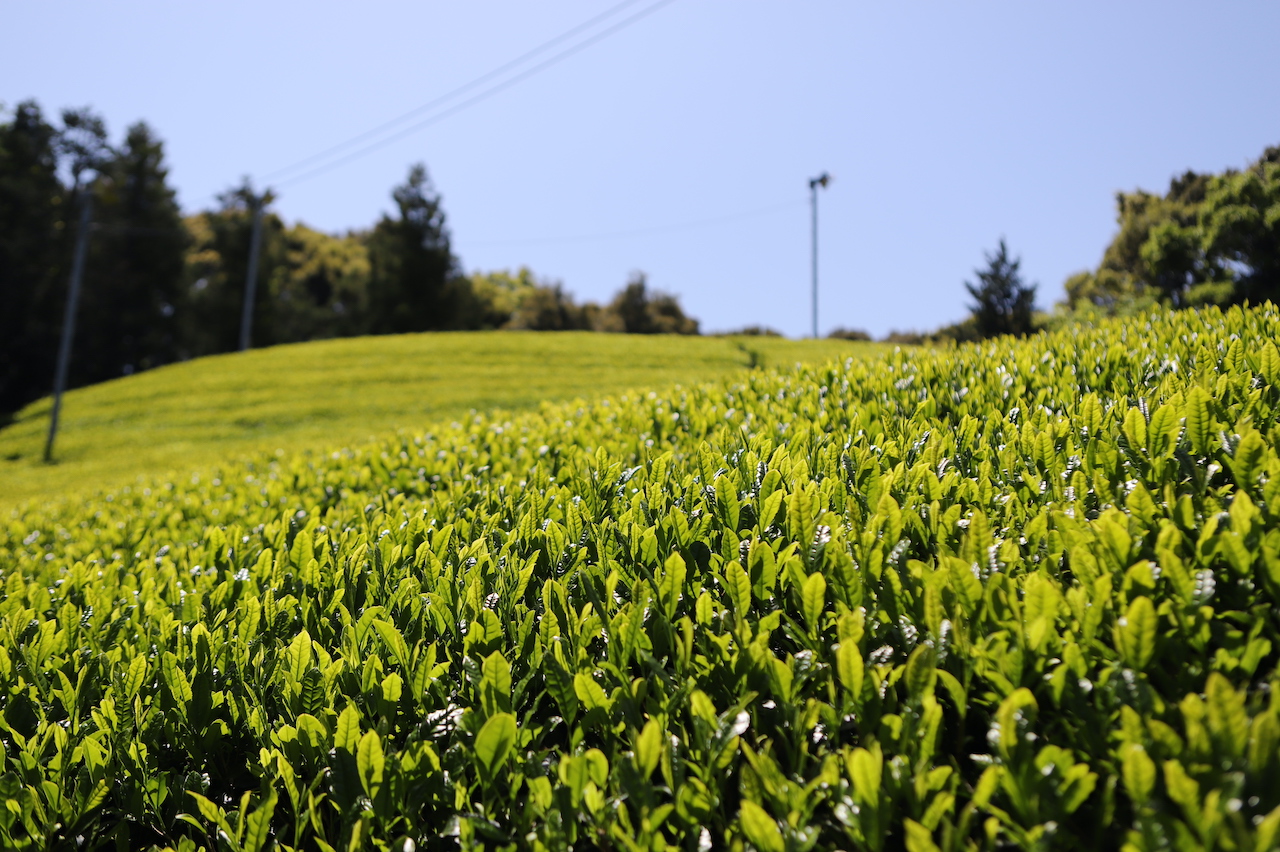
Kakegawa is one of the famous tea production areas in Japan, and has many tea fields in flat land and in mountain areas. The cancer mortality rate of Kakegawa City is the lowest among cities in Japan with populations over 100,000. It is said that people drink a lot of tea in a day, and it may be related to that fact.
Kakegawa City has conducted a study in its city that investigated the connection between green tea and effects of improving lifestyle related diseases.
The tea is cultivated using CHAGUSABA farming method.
The CHAGUSABA farming method has been conducted for many years at several locations in Kakegawa City. The CHAGUSABA farming method is a circular agriculture that maintains the environment around tea fields and is recognized as a Globally Important Agricultural Heritage System (GHIAS) by the Food and Agriculture Organization (FAO) of the United Nations.
CHAGUSABA means semi-natural grasslands around tea fields and CHAGUSA is grass for tea fields.
 CHAGUSA in the tea field
CHAGUSA in the tea field
The tea garden was established in 1915. The philosophy of the tea garden is respect for nature and cultivating tea. These tea farmers do not want to destroy the ecosystem using agricultural chemicals. Thus, they work to make a rich soil using many microscopic organisms and organic compost. If they encounter a problem or difficulty, for example harmful insects, they observe the tea fields and the environment carefully to find a solution. The owner of the tea garden says that it is important to observe the tea fields daily. The owner and staff are always trying to find new methods of cultivating as well as improving tea processing machines in order to make a good tea.
They make various types of tea such as matcha, fukamushicha (deep-steamed green tea), wakocha (Japanese black tea), hojicha (green tea which is steamed and roasted), kukicha (steamed green tea with stems), genmaicha (steamed green tea with roasted brown rice), etc.
They provide a place where people can enjoy their tea and a chance for children to have an experience picking tea leaves to learn about tea. They also contribute to the local community through tea.
 Making nutrient rich soil with CHAGUSA and rice bran
Making nutrient rich soil with CHAGUSA and rice bran
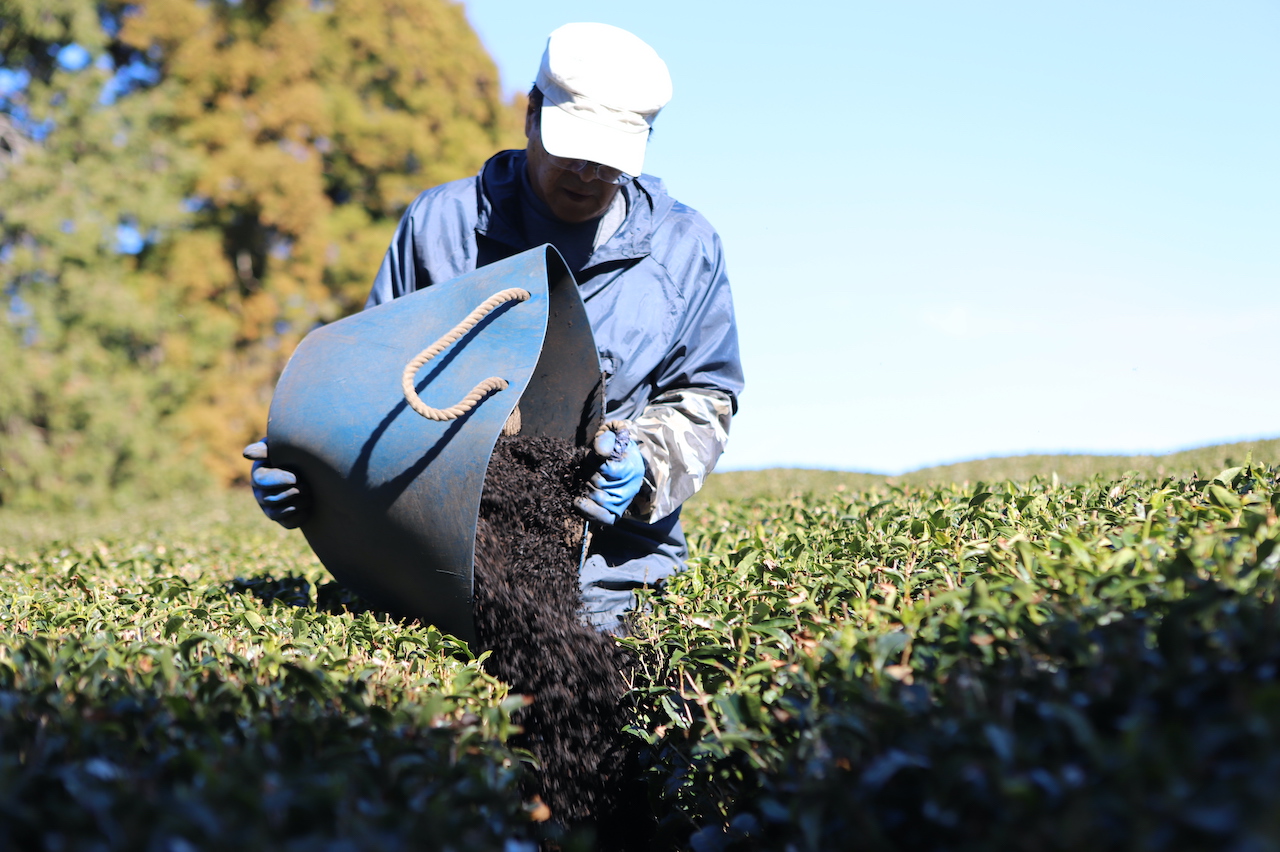 Putting the soil into the tea field
Putting the soil into the tea field
Matcha can be used for various purposes not only for drinking such as shakes or lattes, but also for making bagels, bread, waffles, muffins, ice cream, etc.
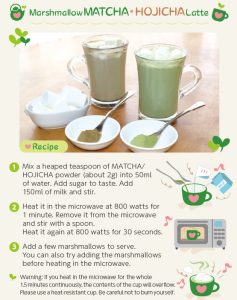
How to make MATCHA/HOJICHA latte
*You can make the Marshmallow MATCHA/HOJICHA latte using a small pan.
 Matcha and Hojicha waffles[/caption]
Matcha and Hojicha waffles[/caption]
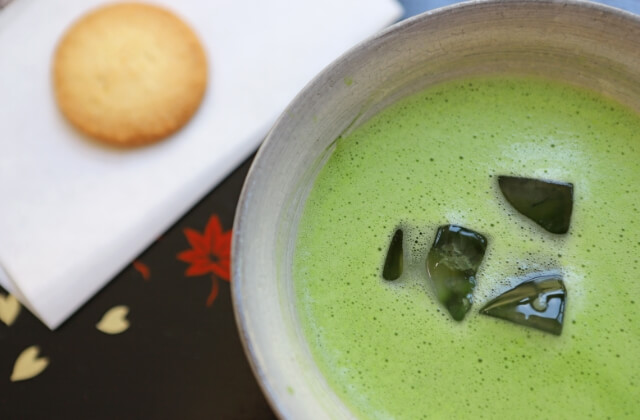 Iced MATCHA
Iced MATCHA
How to make MATCHA/HOJICHA ice cream shake
How to make MATCHA/HOJICHA pound cake
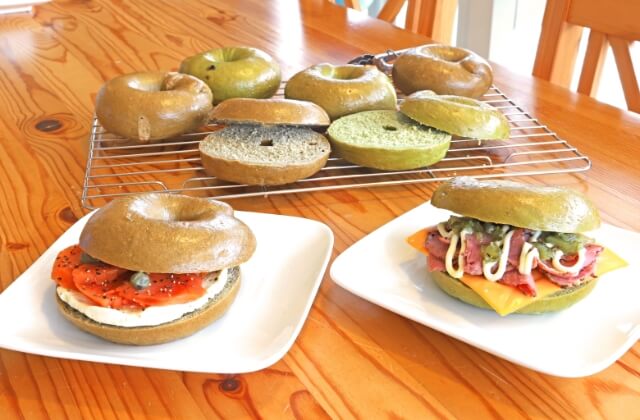 Matcha and Hojicha bagels[/caption]
Matcha and Hojicha bagels[/caption]
Drink and eat TEA LEAF and protect Nature
Now people don’t drink much freshly-brewed tea due to emerging cheap tea in plastic bottles. Tea in a plastic bottle is convenient, but use of many plastic bottles is an environmental problem. If you buy and brew their organic tea, at a good price for the tea farmer, it means that you also maintain the environment through the tea farmers.
If you eat used organic tea leaves, you don’t generate food scraps. It is good for the environment, and you can be a part of circular agriculture.
CHAMART creates the recipes for matcha.
For any inquiry, please contact us.
We can introduce more organic JAS certified Japanese tea on request.
We will first send an estimate for your request.
Please read our Privacy Policy before sending your inquiry.
If you accept, then please contact us.
Thank you for your understanding.
We look forward to hearing from you.
CHAMART
YUtoMI Solutions Co., Ltd.
E-mail: tea@chamart.jp
Tel: +81(0)90-4401-8774
Address: Kakegawa, Shizuoka, Japan
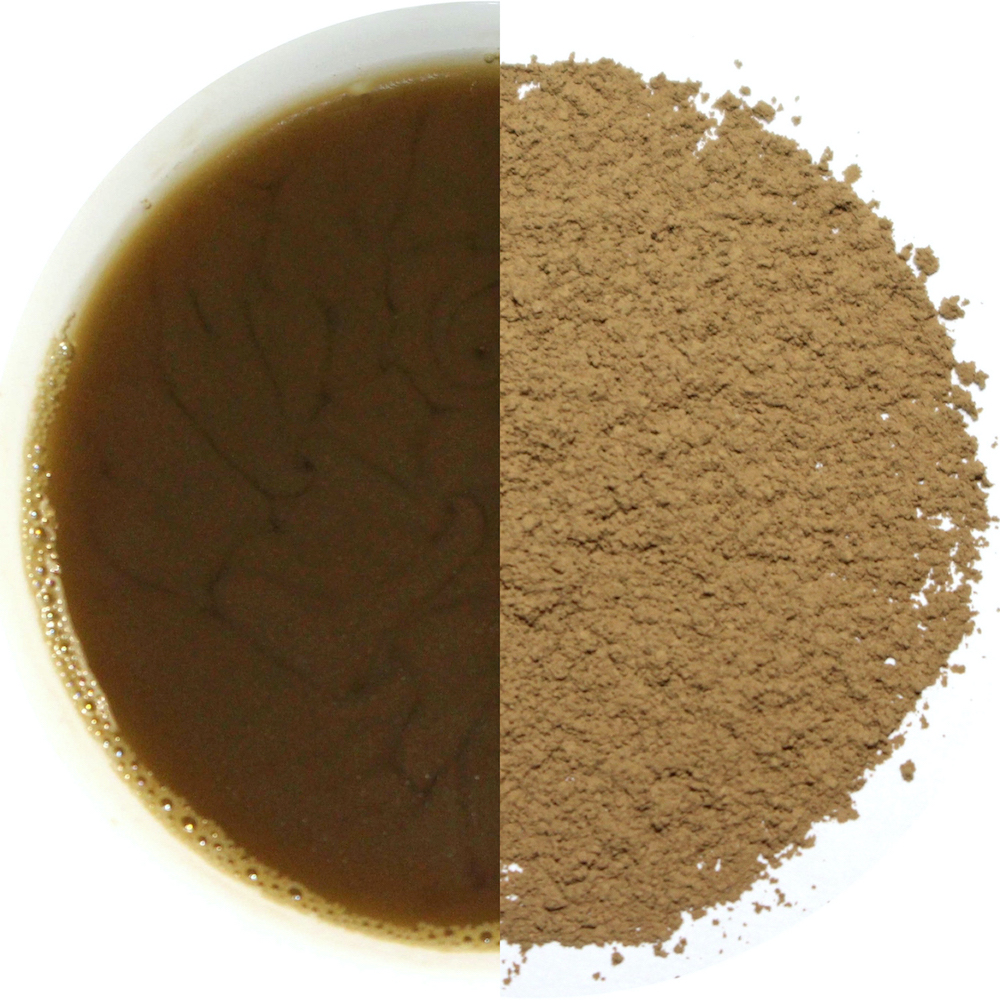
Roasted green tea powder from Kakegawa
ORGANIC JAS
CHAGUSABA

Type of tea
Hojicha (green tea which is steamed and roasted) powder
Production place
Kakegawa City, Shizuoka Prefecture, Japan
Producers of tea
A family-run tea garden that manages the production of tea from cultivation through processing.
Leaf (particle size)
Powder 100 mesh pass (10 µm)
Color of brewed tea
Dark brown
Flavor
Rich roasted aroma, bitter
Other
The hojicha is deep-steamed green tea which is roasted.
Organic farming (certified Organic JAS *)
○
CHAGUSABA farming method *
○
The tea is cultivated using the CHAGUSABA farming method in GIAHS (Globally Important Agricultural Heritage Systems) recognized areas.
*The CHAGUSABA farming method is NOT an organic farming method.
Please refer here for detailed information about this tea, including price, delivery time, MOQ (minimum order quantity), payment, etc.
Please click here for the details of 1, 2, 3 and 4.
1. Organic JAS (Japanese Agricultural Standard)
2. EU Maximum Residue Level (MRL) of Pesticide
3. Examination of Radioactive materials in tea cultivated in Shizuoka Prefecture
4. Tariff rate on green tea to EU and HS code
*CHAGUSABA farming method
A traditional circular agricultural tea farming method “CHAGUSABA” has been conducted primarily in Shizuoka Prefecture for many years.
CHAGUSABA means semi-natural grasslands and CHAGUSA is grass for tea fields. There is much pampas grass, bamboo grass, etc. around the tea fields. Farmers mow the grass and cut them into pieces, then put the cut grass in the furrows between the rows of tea bushes. The grass prevents soil flow & growth of weeds and becomes compost.
The sunlight can reach small flora and fauna because of cutting the grass. Thus, they can continue to live.
Shizuoka’s CHAGUSABA farming method (Traditional Tea-grass Integrated System in Shizuoka) conducted in these four cities (Kakegawa, Kikugawa, Makinohara and Shimada) and one town (Kawanehon) in Shizuoka Prefecture was recognized as a Globally Important Agricultural Heritage System (GIAHS) by the Food and Agriculture Organization of the United Nations (FAO) in 2013. However, the CHAGUSABA farming method has been conducted in some places other than these five locations in Shizuoka Prefecture and in some other prefectures of Japan as well.
*Tea leaves contain caffeine. The diuretic, stimulant and anticancer effects of caffeine intake are clinically recognized. On the other hand, excessive intake of caffeine may have a damaging effect on health. Especially, pregnant or breastfeeding women, and children should be careful with the amount of caffeine they intake.
Reference:
Traditional Tea-grass Integrated System in Shizuoka
GIAHS Globally Important Agricultural Heritage Systems
Food and Agriculture Organization of the United Nations
http://www.fao.org/giahs/giahsaroundtheworld/designated-sites/asia-and-the-pacific/traditional-tea-grass-integrated-system-in-shizuoka/en/
農林水産省 カフェインの過剰摂取について
https://www.maff.go.jp/index.html

Kakegawa is one of the famous tea production areas in Japan, and has many tea fields in flat land and in mountain areas. The cancer mortality rate of Kakegawa City is the lowest among cities in Japan with populations over 100,000. It is said that people drink a lot of tea in a day, and it may be related to that fact.
Kakegawa City has conducted a study in its city that investigated the connection between green tea and effects of improving life style related diseases.
The tea is cultivated using CHAGUSABA farming method.
The CHAGUSABA farming method has been conducted for many years at several locations in Kakegawa City. The CHAGUSABA farming method is a circular agriculture that maintains the environment around tea fields and is recognized as a Globally Important Agricultural Heritage System (GHIAS) by the Food and Agriculture Organization (FAO) of the United Nations.
CHAGUSABA means semi-natural grasslands around tea fields and CHAGUSA is grass for tea fields.
 CHAGUSA in the tea field
CHAGUSA in the tea field
The tea garden was established in 1915. The philosophy of the tea garden is respect for nature and cultivating tea. These tea farmers do not want to destroy the ecosystem using agricultural chemicals. Thus, they work to make a rich soil using many microscopic organisms and organic compost. If they encounter a problem or difficulty, for example harmful insects, they observe the tea fields and the environment carefully to find a solution. The owner of the tea garden says that it is important to observe the tea fields daily. The owner and staff are always trying to find new methods of cultivating as well as improving tea processing machines in order to make a good tea.
They make various types of tea such as matcha, fukamushicha (deep-steamed green tea), wakocha (Japanese black tea), hojicha (green tea which is steamed and roasted), kukicha (steamed green tea with stems), genmaicha (steamed green tea with roasted brown rice), etc.
They provide a place where people can enjoy their tea and a chance for children to have an experience picking tea leaves to learn about tea. They also contribute to the local community through tea.
 Making nutrient rich soil with CHAGUSA and rice bran
Making nutrient rich soil with CHAGUSA and rice bran
 Putting the soil into the tea field
Putting the soil into the tea field
Hojicha powder can be used for various purposes not only for drinking such as shakes, lattes or a type of espresso, but also for making bagels, bread, waffles, muffins, ice cream, etc.

How to make MATCHA/HOJICHA latte
*You can make the Marshmallow Matcha/Hojicha latte using a small pan.
 Hojicha and Matcha muffins & bagels
Hojicha and Matcha muffins & bagels
 Hojicha waffle and Hojicha latte
Hojicha waffle and Hojicha latte
 Hojicha and Matcha bagels
Hojicha and Matcha bagels
How to make Matcha and Hojicha ice cream shake
Hojicha espresso
Put 1g of powdered hojicha into an espresso cup, add boiled water, then stir.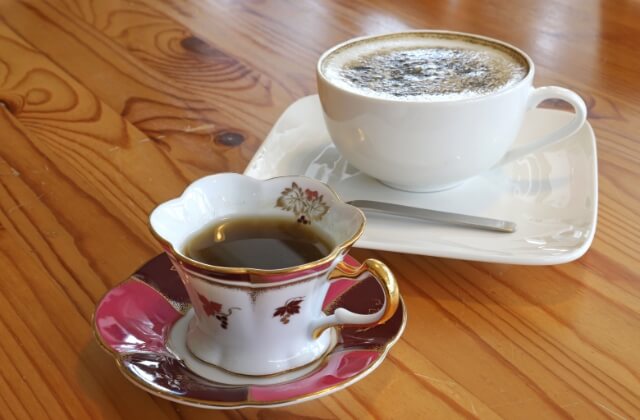
Drink and eat TEA LEAF and protect Nature
Now people don’t drink much freshly-brewed tea due to emerging cheap tea in plastic bottles. Tea in a plastic bottle is convenient, but use of many plastic bottles is an environmental problem. If you buy and brew their organic tea, at a good price for the tea farmer, it means that you also maintain the environment through the tea farmers.
If you eat used organic tea leaves, you don’t generate food scraps. It is good for the environment, and you can be a part of circular agriculture.
CHAMART creates the recipes for Hojicha powder.
For any inquiry, please contact us.
We can introduce more organic JAS certified Japanese tea on request.
We will first send an estimate for your request.
Please read our Privacy Policy before sending your inquiry.
If you accept, then please contact us.
Thank you for your understanding.
We look forward to hearing from you.
 CHAMART
CHAMART
YUtoMI Solutions Co., Ltd.
E-mail: tea@chamart.jp
Tel: +81(0)90-4401-8774
Address: Kakegawa, Shizuoka, Japan
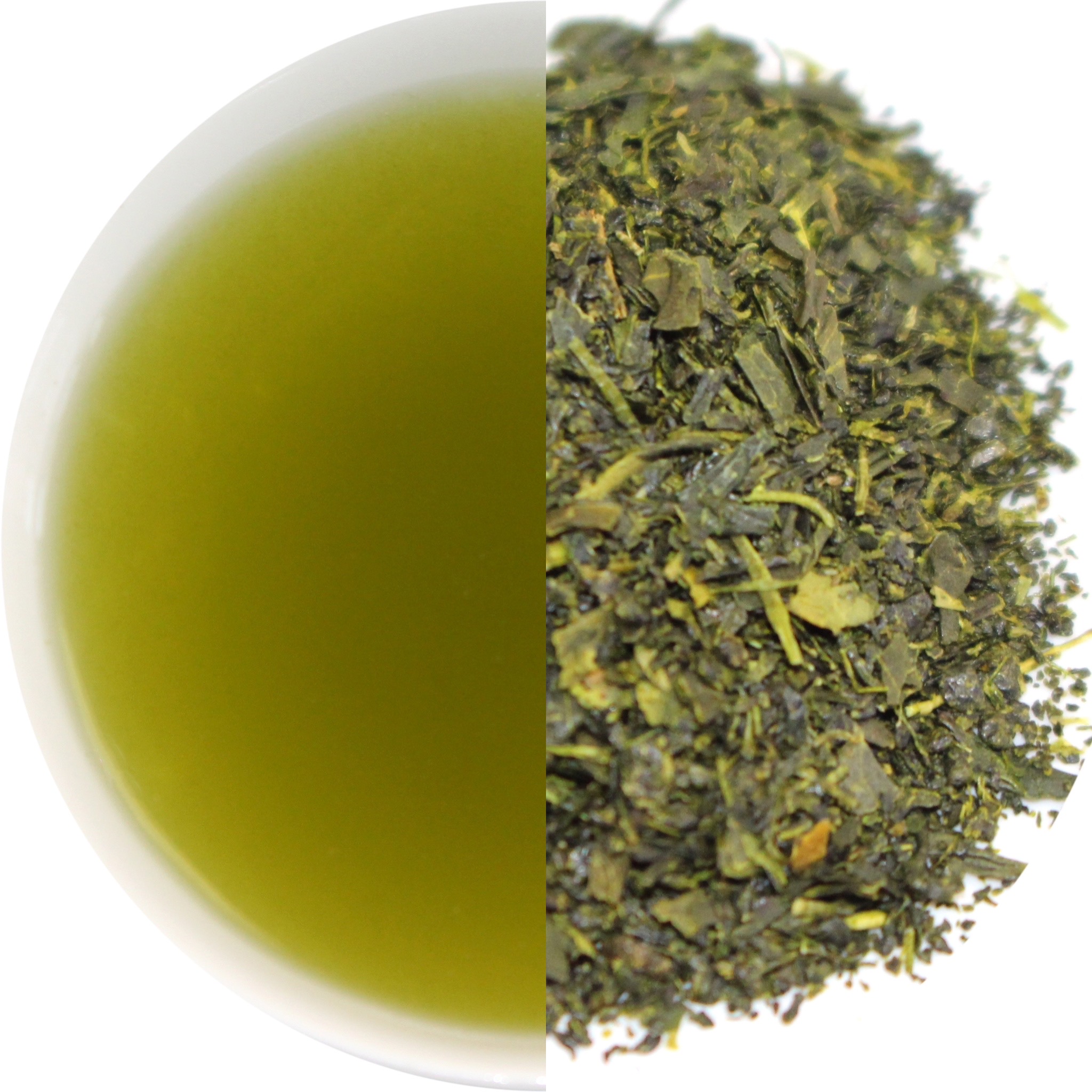
Deep-steamed green tea from Kakegawa
ORGANIC JAS
CHAGUSABA
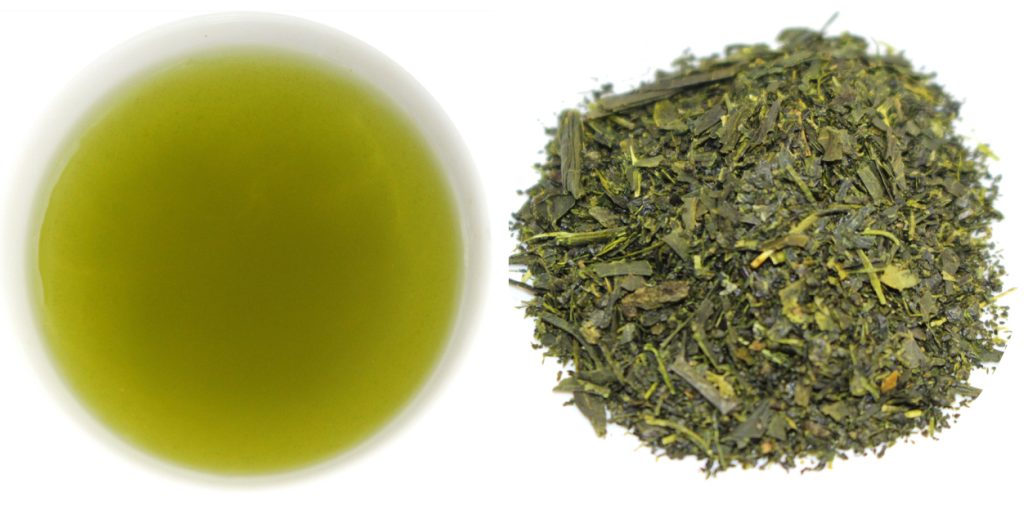
Type of tea
Fukamushicha (deep-steamed green tea)
The leaves are steamed for about 60 to 120 seconds.
Production place
Kakegawa City, Shizuoka Prefecture, Japan
Producers of tea
A tea farmer’s family company
Leaf
Time of steaming tea leaves: about 60 to 120 seconds
Broken into tiny pieces and soft. You can eat the used tea leaves with egg, yogurt, soup, or pasta after brewing.
Color of brewed tea
Dark green, like jade
Flavor
Mild with a slight sweetness, not bitter nor astringent
Other
Tea dust flows in the brewed tea and will sink to the bottom of the teacup. Thus, when drinking FUKAMUSHICHA, please rotate the teacup in order to make the tea dust rise, drinking the tea with tea dust together.
Organic farming (certified Organic JAS *)
○
CHAGUSABA farming method *
○
The tea is cultivated using the CHAGUSABA farming method in GIAHS (Globally Important Agricultural Heritage Systems) recognized areas.
*The CHAGUSABA farming method is NOT an organic farming method.
Please refer here for detailed information about this tea, including price, delivery time, MOQ (minimum order quantity), payment, etc.
Please click here for the details of 1, 2, 3 and 4.
1. Organic JAS (Japanese Agricultural Standard)
2. EU Maximum Residue Level (MRL) of Pesticide
3. Examination of Radioactive materials in tea cultivated in Shizuoka Prefecture
4. Tariff rate on green tea to EU and HS code
*CHAGUSABA farming method
A traditional circular agricultural tea farming method “CHAGUSABA” has been conducted primarily in Shizuoka Prefecture for many years.
CHAGUSABA means semi-natural grasslands and CHAGUSA is grass for tea fields. There is much pampas grass, bamboo grass, etc. around the tea fields. Farmers mow the grass and cut them into pieces, then put the cut grass in the furrows between the rows of tea bushes. The grass prevents soil flow & growth of weeds and becomes compost.
The sunlight can reach small flora and fauna because of cutting the grass. Thus, they can continue to live.
Shizuoka’s CHAGUSABA farming method (Traditional Tea-grass Integrated System in Shizuoka) conducted in these four cities (Kakegawa, Kikugawa, Makinohara and Shimada) and one town (Kawanehon) in Shizuoka Prefecture was recognized as a Globally Important Agricultural Heritage System (GIAHS) by the Food and Agriculture Organization of the United Nations (FAO) in 2013. However, the CHAGUSABA farming method has been conducted in some places other than these five locations in Shizuoka Prefecture and in some other prefectures of Japan as well.
*Tea leaves contain caffeine. The diuretic, stimulant and anticancer effects of caffeine intake are clinically recognized. On the other hand, excessive intake of caffeine may have a damaging effect on health. Especially, pregnant or breastfeeding women, and children should be careful with the amount of caffeine they intake.
Reference:
Traditional Tea-grass Integrated System in Shizuoka
GIAHS Globally Important Agricultural Heritage Systems
Food and Agriculture Organization of the United Nations
http://www.fao.org/giahs/giahsaroundtheworld/designated-sites/asia-and-the-pacific/traditional-tea-grass-integrated-system-in-shizuoka/en/
農林水産省 カフェインの過剰摂取について
https://www.maff.go.jp/index.html

Kakegawa is one of the famous tea production areas in Japan, and has many tea fields in flat land and in mountain areas. The cancer mortality rate of Kakegawa City is the lowest among cities in Japan with populations over 100,000. It is said that people drink a lot of tea in a day, and it may be related to that fact.
Kakegawa City has conducted a study in its city that investigated the connection between green tea and effects of improving life style related diseases.
The tea is cultivated using CHAGUSABA farming method.
The CHAGUSABA farming method has been conducted for many years at several locations in Kakegawa City. The CHAGUSABA farming method is a circular agriculture that maintains the environment around tea fields and is recognized as a Globally Important Agricultural Heritage System (GHIAS) by the Food and Agriculture Organization (FAO) of the United Nations.
CHAGUSABA means semi-natural grasslands around tea fields and CHAGUSA means the grasses for the tea fields.
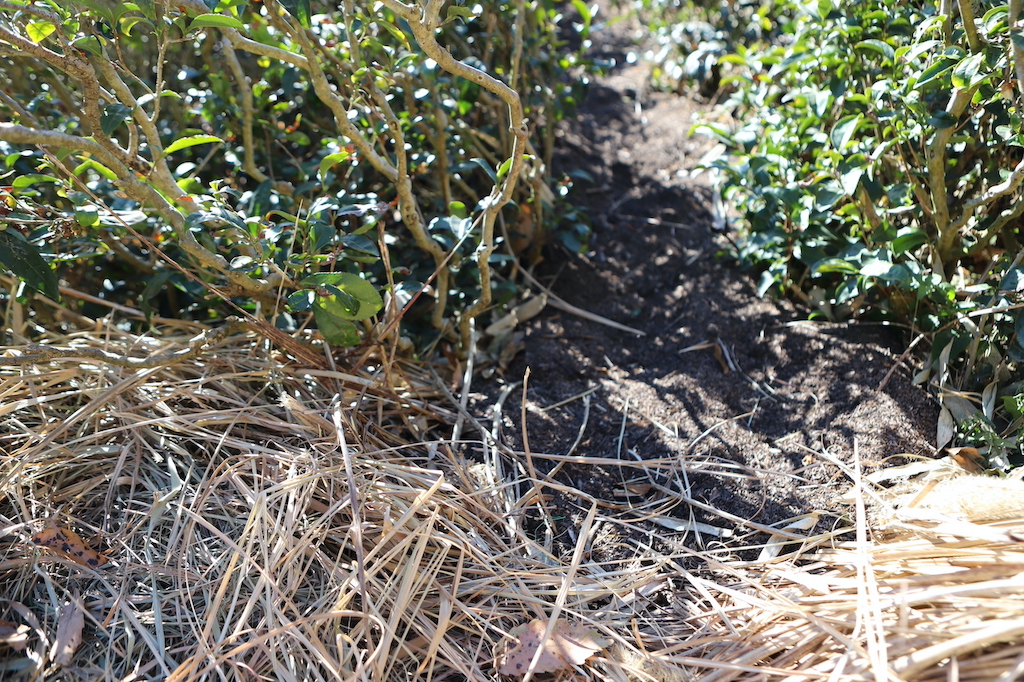 CHAGUSA in the tea field
CHAGUSA in the tea field
The tea garden was established in 1915. The philosophy of the tea garden is respect for nature and cultivating tea. These tea farmers do not want to destroy the ecosystem using agricultural chemicals. Thus, they work to make a rich soil using many microscopic organisms and organic compost. If they encounter a problem or difficulty, for example harmful insects, they observe the tea fields and the environment carefully to find a solution. The owner of the tea garden says that it is important to observe the tea fields daily. The owner and staff are always trying to find new methods of cultivating as well as improving tea processing machines in order to make a good tea.
They make various types of tea such as MATCHA, FUKAMUSHICHA (deep-steamed green tea), WAKOCHA (Japanese black tea), HOJICHA (green tea which is steamed and roasted), KUKICHA (steamed green tea with stems), powdered tea, etc..
They provide a place where people can enjoy their tea and a chance for children to have an experience picking tea leaves to learn about tea. They also contribute to the local community through tea.

Making nutrient rich soil with CHAGUSA and rice bran

Putting the soil into the tea field
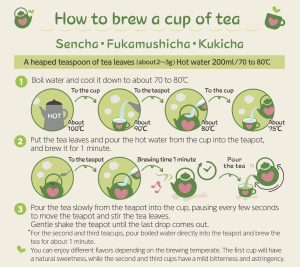
 FUKAMUSHICHA with dried orange
FUKAMUSHICHA with dried orange Carrot pound cake with used tea leaves
Carrot pound cake with used tea leaves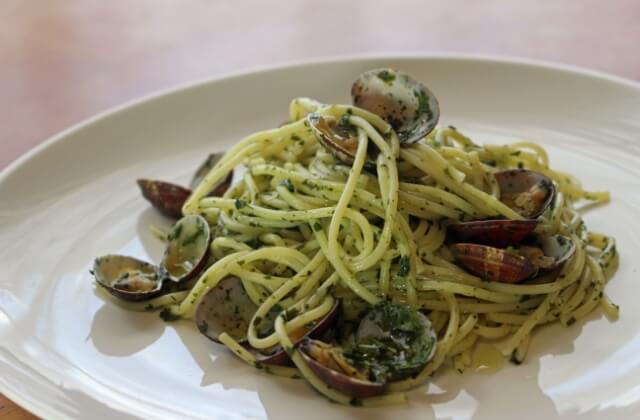
Cold brewing
1.P ut 3 to 5 heaped teaspoons of tea leaves (about 6 to 10g) and 1 litter of water into a bottle.
2. Place in the fridge for 1 to 3 hours.
Adding seasonal fruits and honey is also good.
CHAMART recommends the water is cooled, boiled water or mineral water.
You can use the used tea leaves with pasta, soup and other dishes as well.
CHAMART’s recommendation
1. Put 2.5 or 3 heaped teaspoons of tea leaves (5 to 7g) of leaf tea into a teapot and, pour 1/4 cup (50ml) of cold water into the pot. Then brew the tea for 5 minutes.
2. Pour 1 cup (200ml) of boiled water into the pot, and brew the tea for 3 minutes
You can enjoy tea with strong umami (a kind of glutamine taste).
You can brew more with the tea leaves as you like it.
For brewing a more bitter and fresh taste, brew in boiled water for 1 to 2 minutes.
Drink and eat TEA LEAF and protect Nature
Now people don’t drink much freshly-brewed tea due to emerging cheap tea in plastic bottles. Tea in a plastic bottle is convenient, but use of many plastic bottles is an environmental problem. If you buy and brew their organic tea, at a good price for the tea farmer, it means that you also maintain the environment through the tea farmers.
If you eat used organic tea leaves, you don’t generate food scraps. It is good for the environment, and you can be a part of circular agriculture.
CHAMART creates the recipes for Fukamushicha.
For any inquiry, please contact us.
We can introduce more organic JAS certified Japanese tea on request.
We will first send an estimate for your request.
Please read our Privacy Policy before sending your inquiry.
If you accept, then please contact us.
Thank you for your understanding.
We look forward to hearing from you.
CHAMART
YUtoMI Solutions Co., Ltd.
E-mail: tea@chamart.jp
Tel: +81(0)90-4401-8774
Address: Kakegawa, Shizuoka, Japan
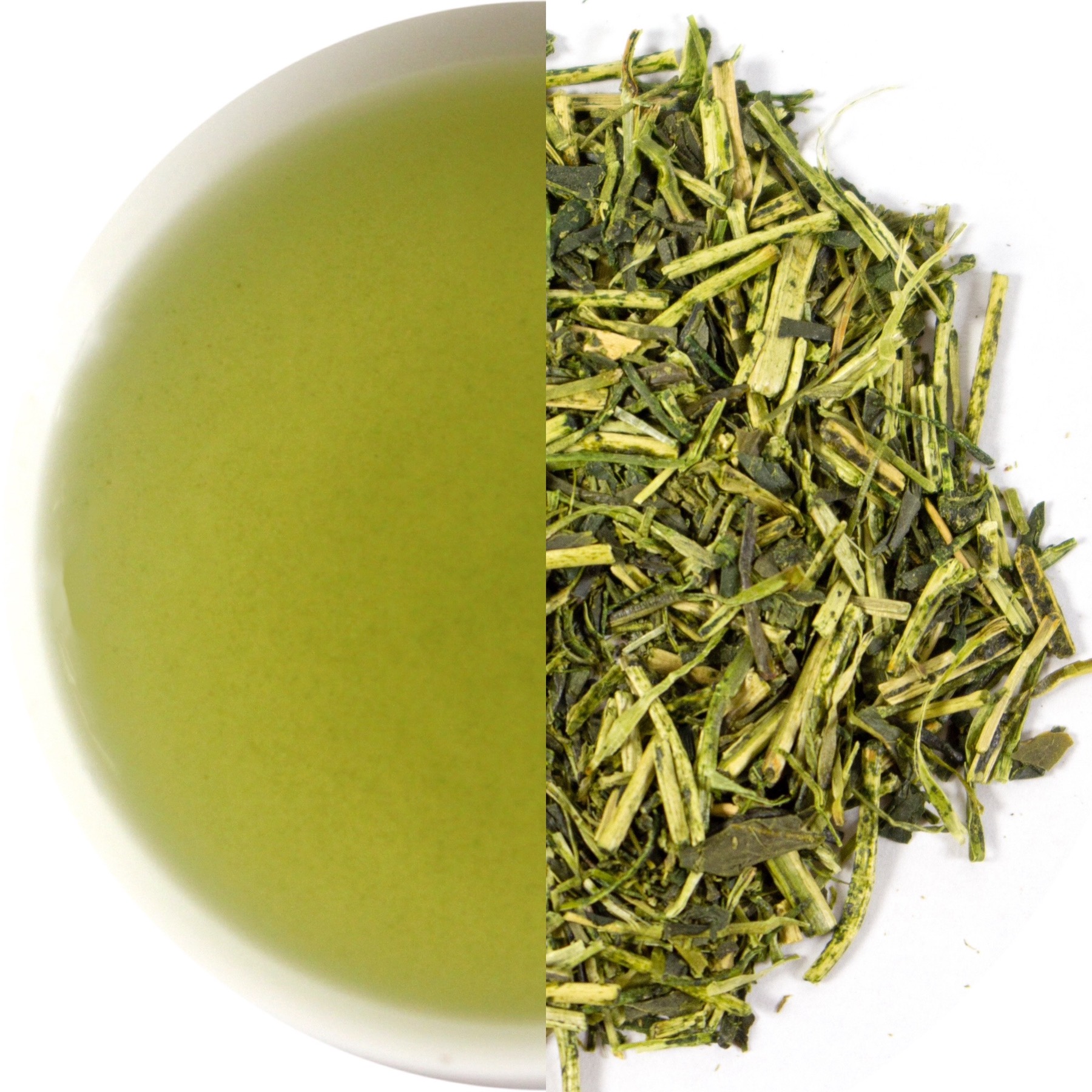
Stem green tea from Kakegawa
ORGANIC JAS
CHAGUSABA
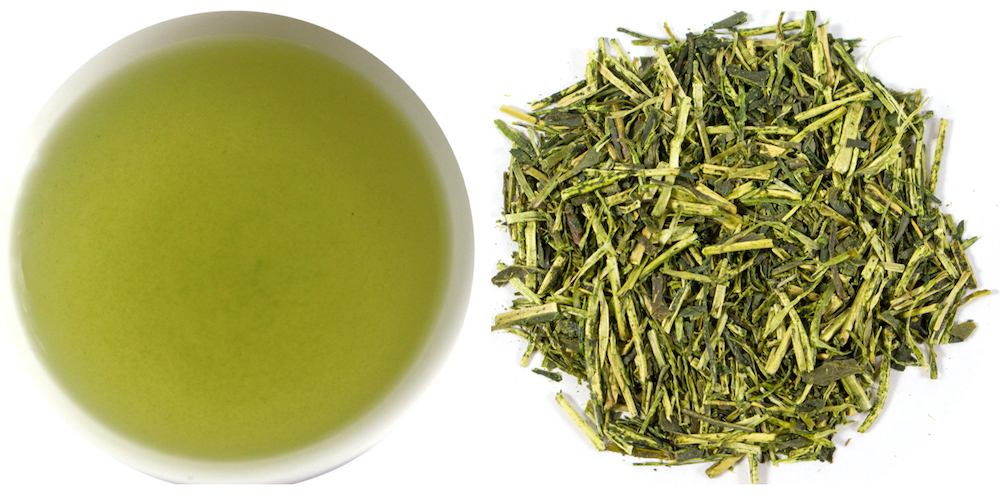
Type of tea
Kukicha (steamed green tea)
The leaves are steamed for about 60 to 120 seconds.
Production place
Kakegawa City, Shizuoka Prefecture, Japan
Producers of tea
A tea farmer’s family company
Leaf
Stems and tiny pieces of leaves
Time of steaming tea leaves: about 60 to 120 seconds
*Due to the long steaming time, the shape of leaves are broken into tiny pieces, but the shape does not reflect the quality of tea.
Color of brewed tea
Dark yellow-green
Flavor
Mild with a slight sweetness and a delicate sweet flower-like aroma, not bitter nor astringent
Other
The stem tea is stem of deep-steamed green tea. Tea particles float in the brewed tea and will sink to the bottom of the teacup. When drinking kukicha, please swirl the teacup in order to make the tea particles rise, so you can enjoy the full flavor of the tea.
Organic farming (certified Organic JAS *)
○
CHAGUSABA farming method *
○
The tea is cultivated using the CHAGUSABA farming method in GIAHS (Globally Important Agricultural Heritage Systems) recognized areas.
*The CHAGUSABA farming method is NOT an organic farming method.
Please refer here for detailed information about this tea, including price, delivery time, MOQ (minimum order quantity), payment, etc.
Please click here for the details of 1, 2, 3 and 4.
1. Organic JAS (Japanese Agricultural Standard)
2. EU Maximum Residue Level (MRL) of Pesticide
3. Examination of Radioactive materials in tea cultivated in Shizuoka Prefecture
4. Tariff rate on green tea to EU and HS code
*CHAGUSABA farming method
A traditional circular agricultural tea farming method “CHAGUSABA” has been conducted primarily in Shizuoka Prefecture for many years.
CHAGUSABA means semi-natural grasslands and CHAGUSA is grass for tea fields. There is much pampas grass, bamboo grass, etc. around the tea fields. Farmers mow the grass and cut them into pieces, then put the cut grass in the furrows between the rows of tea bushes. The grass prevents soil flow & growth of weeds and becomes compost.
The sunlight can reach small flora and fauna because of cutting the grass. Thus, they can continue to live.
Shizuoka’s CHAGUSABA farming method (Traditional Tea-grass Integrated System in Shizuoka) conducted in these four cities (Kakegawa, Kikugawa, Makinohara and Shimada) and one town (Kawanehon) in Shizuoka Prefecture was recognized as a Globally Important Agricultural Heritage System (GIAHS) by the Food and Agriculture Organization of the United Nations (FAO) in 2013. However, the CHAGUSABA farming method has been conducted in some places other than these five locations in Shizuoka Prefecture and in some other prefectures of Japan as well.
*Tea leaves contain caffeine. The diuretic, stimulant and anticancer effects of caffeine intake are clinically recognized. On the other hand, excessive intake of caffeine may have a damaging effect on health. Especially, pregnant or breastfeeding women, and children should be careful with the amount of caffeine they intake.
Reference:
Traditional Tea-grass Integrated System in Shizuoka
GIAHS Globally Important Agricultural Heritage Systems
Food and Agriculture Organization of the United Nations
http://www.fao.org/giahs/giahsaroundtheworld/designated-sites/asia-and-the-pacific/traditional-tea-grass-integrated-system-in-shizuoka/en/
農林水産省 カフェインの過剰摂取について
https://www.maff.go.jp/index.html

Kakegawa is one of the famous tea production areas in Japan, and has many tea fields in flat land and in mountain areas. The cancer mortality rate of Kakegawa City is the lowest among cities in Japan with populations over 100,000. It is said that people drink a lot of tea in a day, and it may be related to that fact.
Kakegawa City has conducted a study in its city that investigated the connection between green tea and effects of improving life style related diseases.
The tea is cultivated using CHAGUSABA farming method.
The CHAGUSABA farming method has been conducted for many years at several locations in Kakegawa City. The CHAGUSABA farming method is a circular agriculture that maintains the environment around tea fields and is recognized as a Globally Important Agricultural Heritage System (GHIAS) by the Food and Agriculture Organization (FAO) of the United Nations.
CHAGUSABA means semi-natural grasslands around tea fields and CHAGUSA means the grasses for the tea fields.
 CHAGUSA in the tea field
CHAGUSA in the tea field
The tea garden was established in 1915. The philosophy of the tea garden is respect for nature and cultivating tea. These tea farmers do not want to destroy the ecosystem using agricultural chemicals. Thus, they work to make a rich soil using many microscopic organisms and organic compost. If they encounter a problem or difficulty, for example harmful insects, they observe the tea fields and the environment carefully to find a solution. The owner of the tea garden says that it is important to observe the tea fields daily. The owner and staff are always trying to find new methods of cultivating as well as improving tea processing machines in order to make a good tea.
They make various types of tea such as MATCHA, FUKAMUSHICHA (deep-steamed green tea), WAKOCHA (Japanese black tea), HOJICHA (green tea which is steamed and roasted), KUKICHA (steamed green tea with stems), powdered tea, etc..
They provide a place where people can enjoy their tea and a chance for children to have an experience picking tea leaves to learn about tea. They also contribute to the local community through tea.

Making nutrient rich soil with CHAGUSA and rice bran

Putting the soil into the tea field
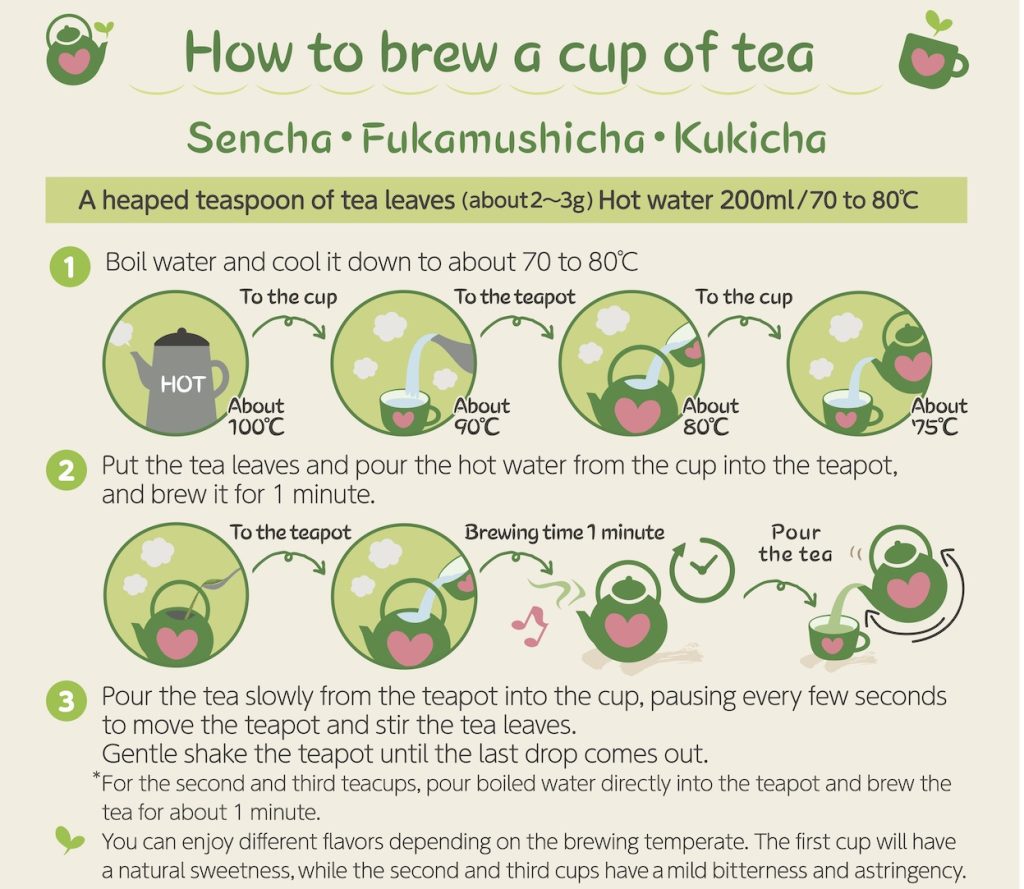
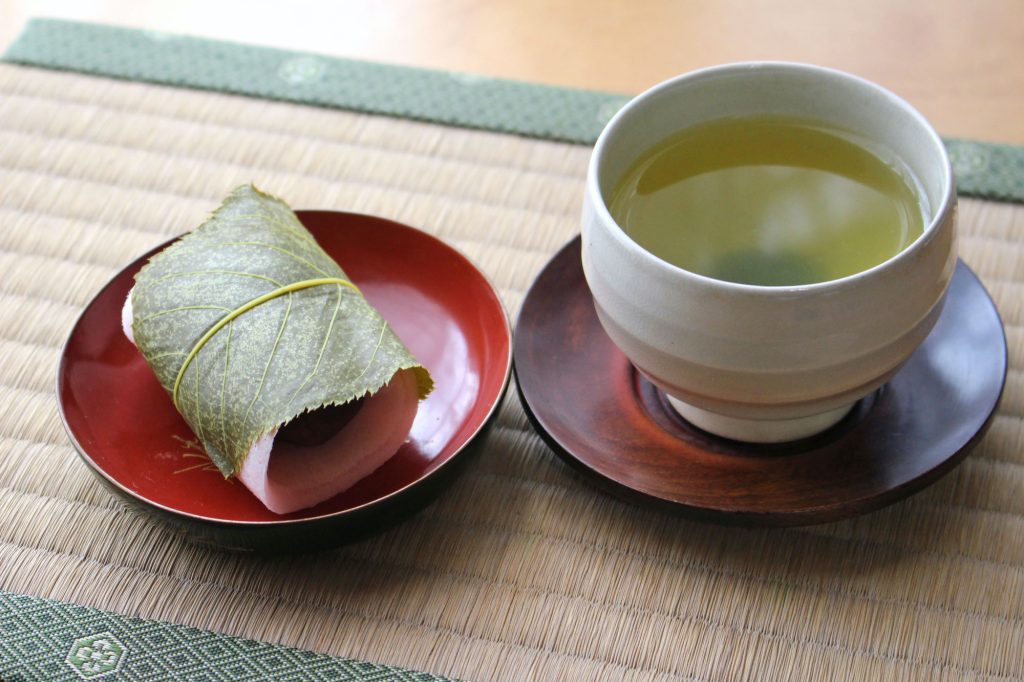
Cold brewing
1.Put 3 to 5 heaped teaspoons of tea leaves (about 6 to 10g) and 1 litter of water into a bottle.
2.Place in the fridge for 1 to 3 hours.
Adding seasonal fruits and honey is also good.
CHAMART recommends the water is cooled, boiled water or mineral water.
You can use the used tea leaves with pasta, soup and other dishes as well.
CHAMART’s recommendation
1. Put 2.5 or 3 heaped teaspoons of tea leaves (5 to 7g) of leaf tea into a teapot and, pour 1/4 cup (50ml) of cold water into the pot. Then brew the tea for 5 minutes.
2. Pour 1 cup (200ml) of boiled water into the pot, and brew the tea for 3 minutes
You can enjoy tea with strong umami (a kind of glutamine taste).
You can brew more with the tea leaves as you like it.
For brewing a more bitter and fresh taste, brew in boiled water for 1 to 2 minutes.
Drink and eat TEA LEAF and protect Nature
Now people don’t drink much freshly-brewed tea due to emerging cheap tea in plastic bottles. Tea in a plastic bottle is convenient, but use of many plastic bottles is an environmental problem. If you buy and brew their organic tea, at a good price for the tea farmer, it means that you also maintain the environment through the tea farmers.
If you eat used organic tea leaves, you don’t generate food scraps. It is good for the environment, and you can be a part of circular agriculture.
CHAMART creates the recipes for Fukamushicha.
For any inquiry (Price, Delivery time, MOQ/Minimum Order Quantity, Payment terms, Japanese tea tourism, etc.), please contact us.
We can introduce more organic JAS certified Japanese tea on request.
We will first send an estimate for your request.
Please read our Privacy Policy before sending your inquiry.
If you accept, then please contact us.
Thank you for your understanding.
We look forward to hearing from you.
CHAMART
YUtoMI Solutions Co., Ltd.
E-mail: tea@chamart.jp
Tel: +81(0)90-4401-8774
Address: Kakegawa, Shizuoka, Japan
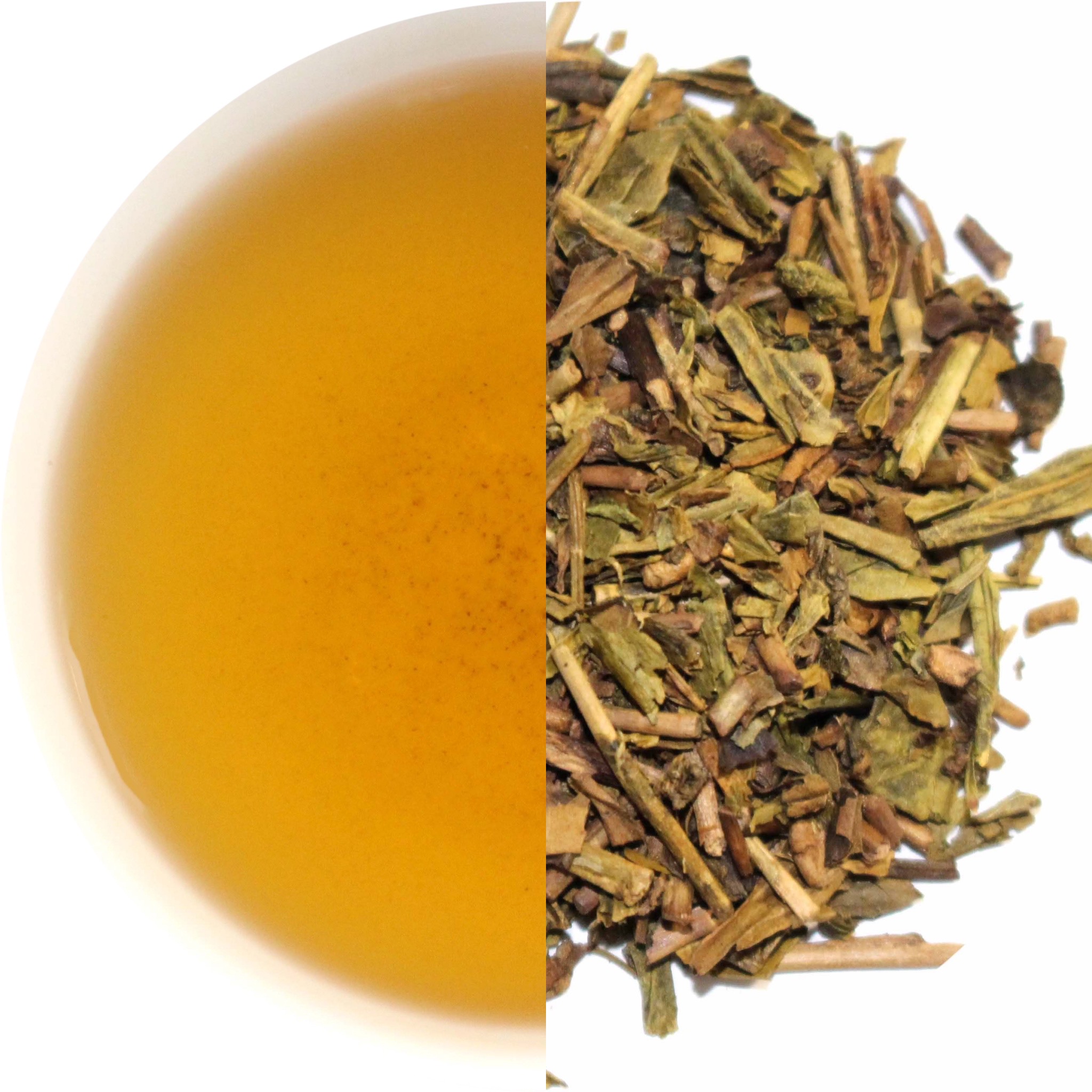
Roasted green tea leaf from Kakegawa
ORGANIC JAS
CHAGUSABA
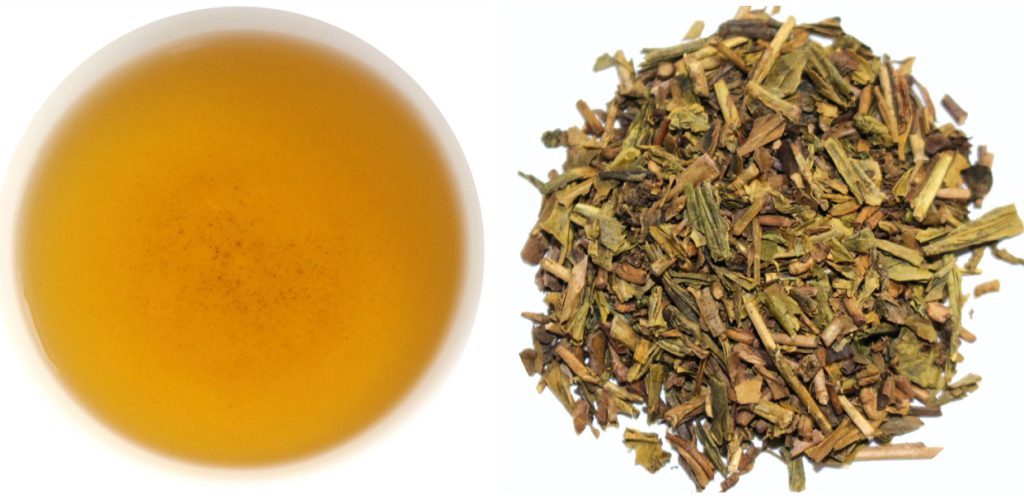
Type of tea
Hojicha (green tea which is steamed and roasted)
Production place
Kakegawa City, Shizuoka Prefecture, Japan
Producers of tea
A family-run tea garden that manages the production of tea from cultivation through processing.
Leaf
Leaf with stem, roasted, slightly hard
Color of brewed tea
Light brown
Flavor
Rich roasted, mild bitter with a slight acid taste and astringent
Other
Hojicha leaf can be used for various purposes not only for drinking such as hojicha with milk or mint, but also for cheese risotto, jerry, etc.
Organic farming (certified Organic JAS *)
○
CHAGUSABA farming method *
○
The tea is cultivated using the CHAGUSABA farming method in GIAHS (Globally Important Agricultural Heritage Systems) recognized areas.
*The CHAGUSABA farming method is NOT an organic farming method.
Please refer here for detailed information about this tea, including price, delivery time, MOQ (minimum order quantity), payment, etc.
Please click here for the details of 1, 2, 3 and 4.
1. Organic JAS (Japanese Agricultural Standard)
2. EU Maximum Residue Level (MRL) of Pesticide
3. Examination of Radioactive materials in tea cultivated in Shizuoka Prefecture
4. Tariff rate on green tea to EU and HS code
*CHAGUSABA farming method
A traditional circular agricultural tea farming method “CHAGUSABA” has been conducted primarily in Shizuoka Prefecture for many years.
CHAGUSABA means semi-natural grasslands and CHAGUSA is grass for tea fields. There is much pampas grass, bamboo grass, etc. around the tea fields. Farmers mow the grass and cut them into pieces, then put the cut grass in the furrows between the rows of tea bushes. The grass prevents soil flow & growth of weeds and becomes compost.
The sunlight can reach small flora and fauna because of cutting the grass. Thus, they can continue to live.
Shizuoka’s CHAGUSABA farming method (Traditional Tea-grass Integrated System in Shizuoka) conducted in these four cities (Kakegawa, Kikugawa, Makinohara and Shimada) and one town (Kawanehon) in Shizuoka Prefecture was recognized as a Globally Important Agricultural Heritage System (GIAHS) by the Food and Agriculture Organization of the United Nations (FAO) in 2013. However, the CHAGUSABA farming method has been conducted in some places other than these five locations in Shizuoka Prefecture and in some other prefectures of Japan as well.
*Tea leaves contain caffeine. The diuretic, stimulant and anticancer effects of caffeine intake are clinically recognized. On the other hand, excessive intake of caffeine may have a damaging effect on health. Especially, pregnant or breastfeeding women, and children should be careful with the amount of caffeine they intake.
Reference:
Traditional Tea-grass Integrated System in Shizuoka
GIAHS Globally Important Agricultural Heritage Systems
Food and Agriculture Organization of the United Nations
http://www.fao.org/giahs/giahsaroundtheworld/designated-sites/asia-and-the-pacific/traditional-tea-grass-integrated-system-in-shizuoka/en/
農林水産省 カフェインの過剰摂取について
https://www.maff.go.jp/index.html

Kakegawa is one of the famous tea production areas in Japan, and has many tea fields in flat land and in mountain areas. The cancer mortality rate of Kakegawa City is the lowest among cities in Japan with populations over 100,000. It is said that people drink a lot of tea in a day, and it may be related to that fact.
Kakegawa City has conducted a study in its city that investigated the connection between green tea and effects of improving life style related diseases.
The tea is cultivated using CHAGUSABA farming method.
The CHAGUSABA farming method has been conducted for many years at several locations in Kakegawa City. The CHAGUSABA farming method is a circular agriculture that maintains the environment around tea fields and is recognized as a Globally Important Agricultural Heritage System (GHIAS) by the Food and Agriculture Organization (FAO) of the United Nations.
CHAGUSABA means semi-natural grasslands around tea fields and CHAGUSA is grass for tea fields.
 CHAGUSA in the tea field[/caption]
CHAGUSA in the tea field[/caption]
The tea garden was established in 1915. The philosophy of the tea garden is respect for nature and cultivating tea. These tea farmers do not want to destroy the ecosystem using agricultural chemicals. Thus, they work to make a rich soil using many microscopic organisms and organic compost. If they encounter a problem or difficulty, for example harmful insects, they observe the tea fields and the environment carefully to find a solution. The owner of the tea garden says that it is important to observe the tea fields daily. The owner and staff are always trying to find new methods of cultivating as well as improving tea processing machines in order to make a good tea.
They make various types of tea such as MATCHA, FUKAMUSHICHA (deep-steamed green tea), WAKOCHA (Japanese black tea), HOJICHA (green tea which is steamed and roasted), KUKICHA (steamed green tea with stems), powdered tea, etc..
They provide a place where people can enjoy their tea and a chance for children to have an experience picking tea leaves to learn about tea. They also contribute to the local community through tea.
 Making nutrient rich soil with CHAGUSA and rice bran[/caption]
Making nutrient rich soil with CHAGUSA and rice bran[/caption]
 Putting the soil into the tea field[/caption]
Putting the soil into the tea field[/caption]
Hojicha leaf can be used for various purposes not only for drinking such as hojicha with milk or mint, but also for cheese risotto, jerry, etc.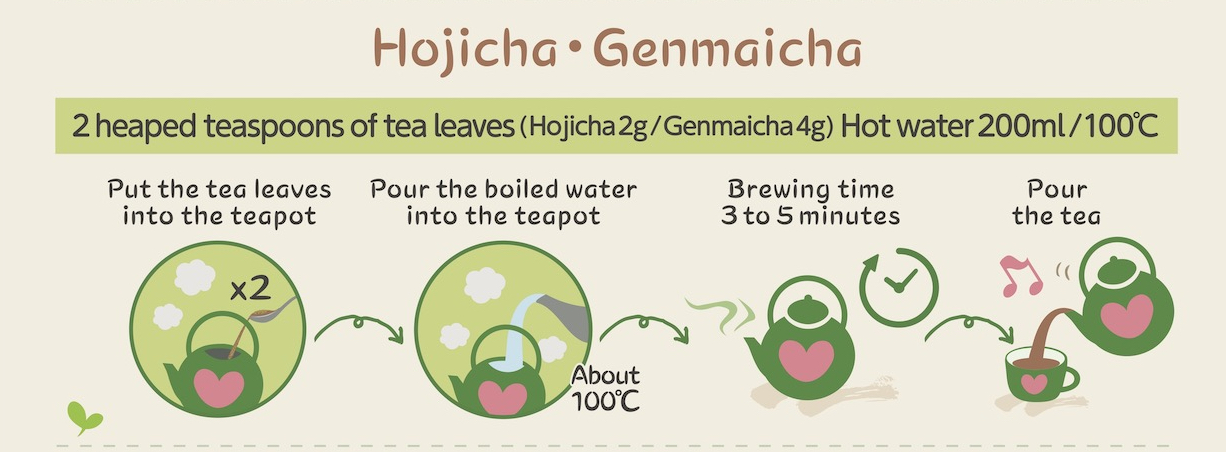
 Hojicha milk
Hojicha milk
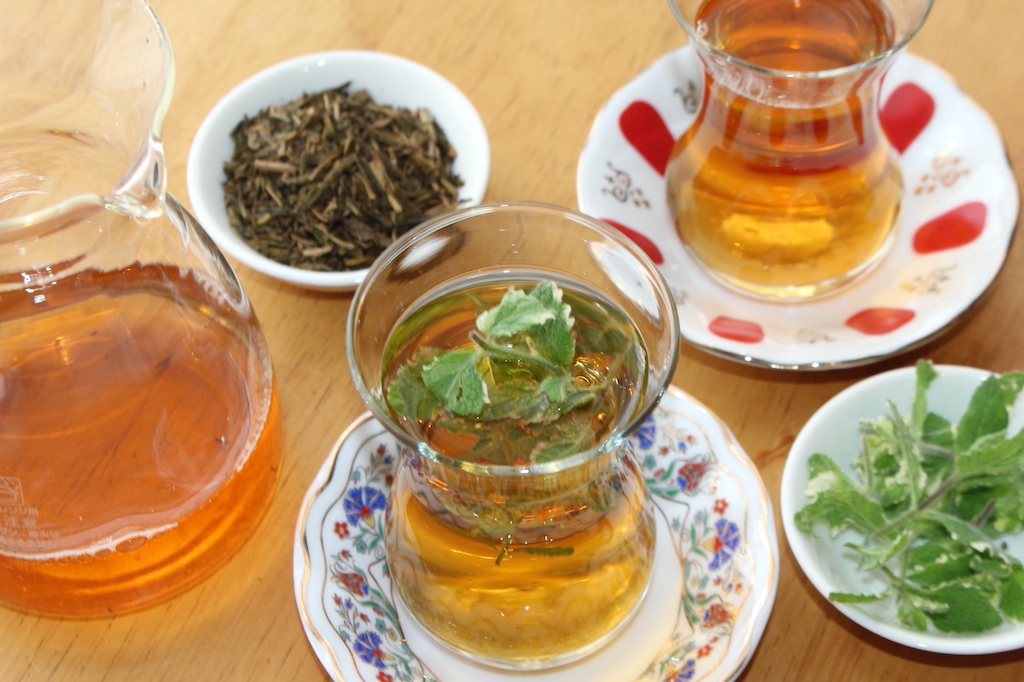 Hojicha with mint leaves
Hojicha with mint leaves
 Hojicha jelly
Hojicha jelly
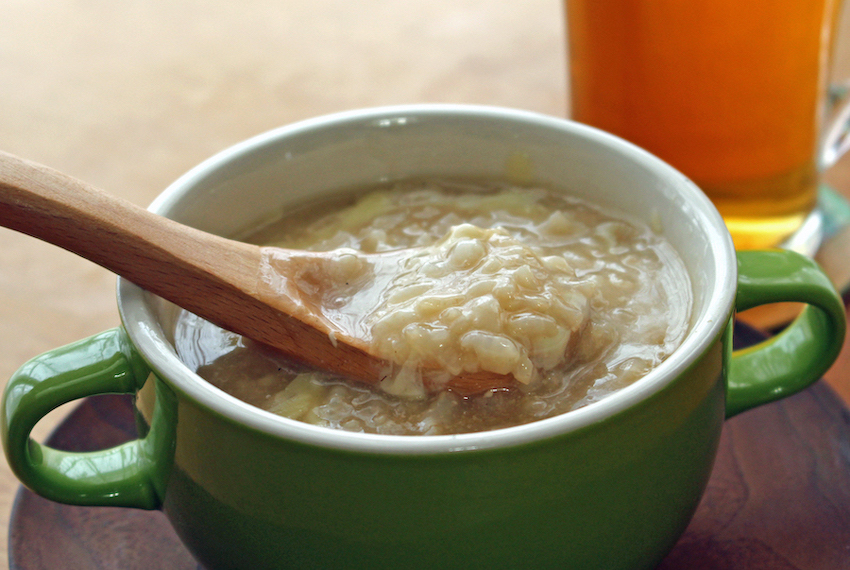 Hojicha risotto
Hojicha risotto
HOJICHA straight/adding mint, black pepper or cinnamon sugar
1.Pour boiled water into a teapot, then pour the water into a teacup or mug (about 200 to 220ml). You can warm up the teapot and cup and cool down the temperature of boiled water (about 85℃) by doing this.
The feel of a cup with 85℃ water is such that you can hold the cup somehow. Be careful not to burn yourself.
Sensitivity to heat depends on the person and the cup.
2. Use 3 heaped teaspoons of tea leaves (3g), and pour the water into the tea pot from the cup.
3. Brew the tea for 3 to 5 minutes. If you like bitterness, brew for 4 or 5 minutes.
4. Pour the tea into the cup.
Adding mint leaves, black pepper or cinnamon sugar is also good.
Try several combinations to find your favorite strength.
You can brew more with the tea leaves as you like.
Cold brewing
1. Put 5 to 10 heaped teaspoons of tea leaves (5 to 10g) and 1 litter of water into a bottle.
Place in the fridge for 1 to 3 hours.
2. Adding mint leaves is also good.
CHAMART recommends the water is cooled, boiled water or mineral water.
The farmer’s recommendation for 1 cup
1. Place 2 heaped teaspoons of tea leaves (2g) in a tea pot, and pour 200ml of boiled water into the tea pot.
2. Brew the tea for 30 to 40 seconds.
3. Pour the tea into the cup.
Drink and eat TEA LEAF and protect Nature
Now people don’t drink much freshly-brewed tea due to emerging cheap tea in plastic bottles. Tea in a plastic bottle is convenient, but use of many plastic bottles is an environmental problem. If you buy and brew their organic tea, at a good price for the tea farmer, it means that you also maintain the environment through the tea farmers.
If you eat used organic tea leaves, you don’t generate food scraps. It is good for the environment, and you can be a part of circular agriculture.
CHAMART creates the recipes for Hojicha leaf.
For any inquiry (Price, Delivery time, MOQ/Minimum Order Quantity, Payment terms, Japanese tea tourism, etc.), please contact us.
We can introduce more organic JAS certified Japanese tea on request.
We will first send an estimate for your request.
Please read our Privacy Policy before sending your inquiry.
If you accept, then please contact us.
Thank you for your understanding.
We look forward to hearing from you.
CHAMART
YUtoMI Solutions Co., Ltd.
E-mail: tea@chamart.jp
Tel: +81(0)90-4401-8774
Address: Kakegawa, Shizuoka, Japan
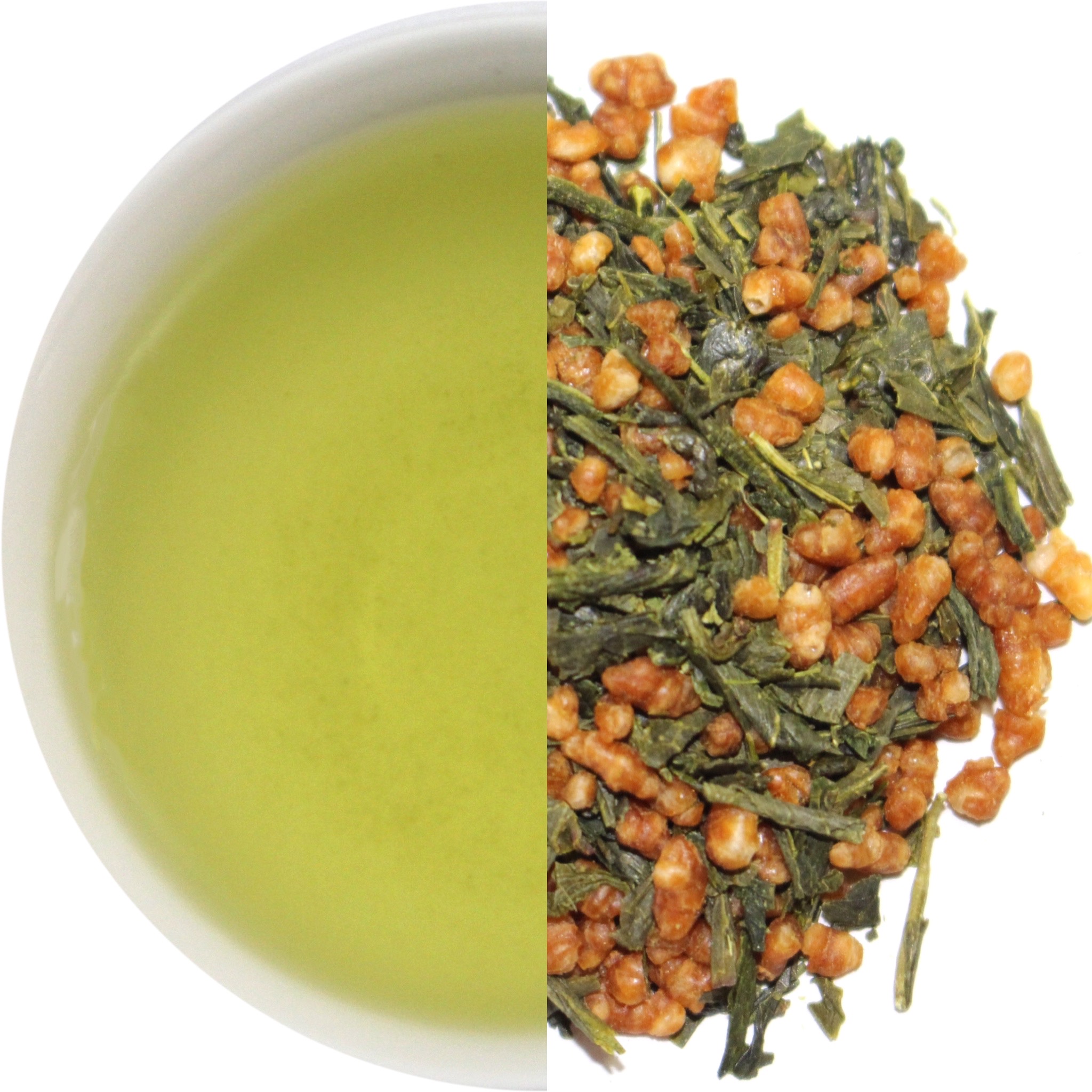
Green tea with roasted brown rice from Kakegawa
ORGANIC JAS
CHAGUSABA
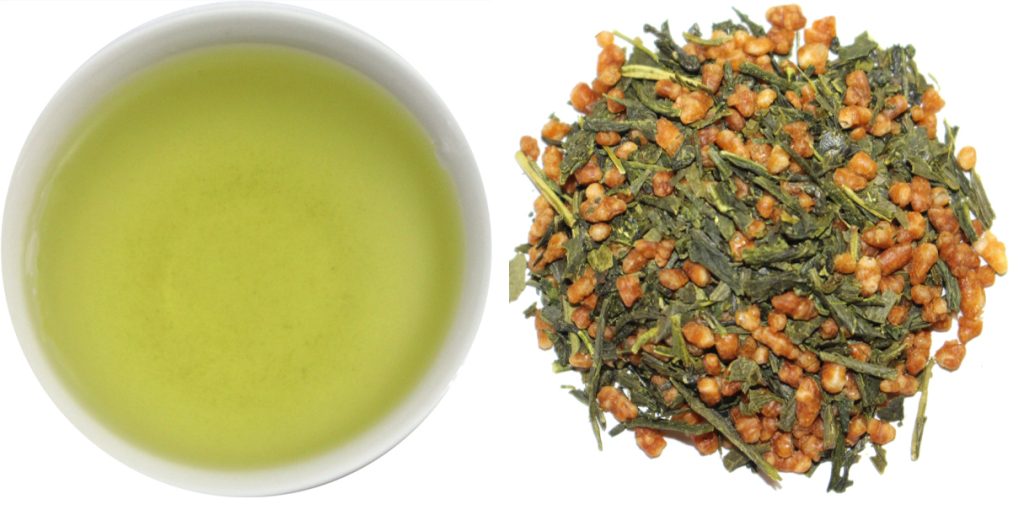
Type of tea
GENMAI-CHA (Steamed green tea with roasted brown rice)
Production place
Kakegawa City, Shizuoka Prefecture, Japan
Producers of tea
A family-run tea garden that manages the production of tea from cultivation through processing
Leaf
Leaf, stem and roasted brown rice (about 60% of leaves & stems and 40% of roasted brown rice)
Color of brewed tea
Clear, pale yellow
Flavor
Slightly roasted rice aroma, a little sweetness, not bitter
Other
The leaves are matured for 2 to 3 years in a refrigerator. They are mixed with new, soft leaves picked in May or June, giving the tea a complicated rich flavor.
Organic farming (certified Organic JAS *)
○
CHAGUSABA farming method *
○
The tea is cultivated using the CHAGUSABA farming method in GIAHS (Globally Important Agricultural Heritage Systems) recognized areas.
*The CHAGUSABA farming method is NOT an organic farming method.
Please refer here for detailed information about this tea, including price, delivery time, MOQ (minimum order quantity), payment, etc.
Please click here for the details of 1, 2, 3 and 4.
1. Organic JAS (Japanese Agricultural Standard)
2. EU Maximum Residue Level (MRL) of Pesticide
3. Examination of Radioactive materials in tea cultivated in Shizuoka Prefecture
4. Tariff rate on green tea to EU and HS code
*CHAGUSABA farming method
A traditional circular agricultural tea farming method “CHAGUSABA” has been conducted primarily in Shizuoka Prefecture for many years.
CHAGUSABA means semi-natural grasslands and CHAGUSA is grass for tea fields. There is much pampas grass, bamboo grass, etc. around the tea fields. Farmers mow the grass and cut them into pieces, then put the cut grass in the furrows between the rows of tea bushes. The grass prevents soil flow & growth of weeds and becomes compost.
The sunlight can reach small flora and fauna because of cutting the grass. Thus, they can continue to live.
Shizuoka’s CHAGUSABA farming method (Traditional Tea-grass Integrated System in Shizuoka) conducted in these four cities (Kakegawa, Kikugawa, Makinohara and Shimada) and one town (Kawanehon) in Shizuoka Prefecture was recognized as a Globally Important Agricultural Heritage System (GIAHS) by the Food and Agriculture Organization of the United Nations (FAO) in 2013. However, the CHAGUSABA farming method has been conducted in some places other than these five locations in Shizuoka Prefecture and in some other prefectures of Japan as well.
*Tea leaves contain caffeine. The diuretic, stimulant and anticancer effects of caffeine intake are clinically recognized. On the other hand, excessive intake of caffeine may have a damaging effect on health. Especially, pregnant or breastfeeding women, and children should be careful with the amount of caffeine they intake.
Reference:
Traditional Tea-grass Integrated System in Shizuoka
GIAHS Globally Important Agricultural Heritage Systems
Food and Agriculture Organization of the United Nations
http://www.fao.org/giahs/giahsaroundtheworld/designated-sites/asia-and-the-pacific/traditional-tea-grass-integrated-system-in-shizuoka/en/
農林水産省 カフェインの過剰摂取について
https://www.maff.go.jp/index.html

Kakegawa is one of the famous tea production areas in Japan, and has many tea fields in flat land and in mountain areas. The cancer mortality rate of Kakegawa City is the lowest among cities in Japan with populations over 100,000. It is said that people drink a lot of tea in a day, and it may be related to that fact.
Kakegawa City has conducted a study in its city that investigated the connection between green tea and effects of improving life style related diseases.
The tea is cultivated using CHAGUSABA farming method.
The CHAGUSABA farming method has been conducted for many years at several locations in Kakegawa City. The CHAGUSABA farming method is a circular agriculture that maintains the environment around tea fields and is recognized as a Globally Important Agricultural Heritage System (GHIAS) by the Food and Agriculture Organization (FAO) of the United Nations.
CHAGUSABA means semi-natural grasslands around tea fields and CHAGUSA is grass for tea fields.
 CHAGUSA in the tea field
CHAGUSA in the tea field
The tea garden was established in 1915. The philosophy of the tea garden is respect for nature and cultivating tea. These tea farmers do not want to destroy the ecosystem using agricultural chemicals. Thus, they work to make a rich soil using many microscopic organisms and organic compost. If they encounter a problem or difficulty, for example harmful insects, they observe the tea fields and the environment carefully to find a solution. The owner of the tea garden says that it is important to observe the tea fields daily. The owner and staff are always trying to find new methods of cultivating as well as improving tea processing machines in order to make a good tea.
They make various types of tea such as matcha, fukamushicha (deep-steamed green tea), wakocha (Japanese black tea), hojicha (green tea which is steamed and roasted), kikucha (steamed green tea with stems), genmaicha (steamed green tea with roasted brown rice), etc..
They provide a place where people can enjoy their tea and a chance for children to have an experience picking tea leaves to learn about tea. They also contribute to the local community through tea.
 Making nutrient rich soil with CHAGUSA and rice bran
Making nutrient rich soil with CHAGUSA and rice bran
 Putting the soil into the tea field
Putting the soil into the tea field

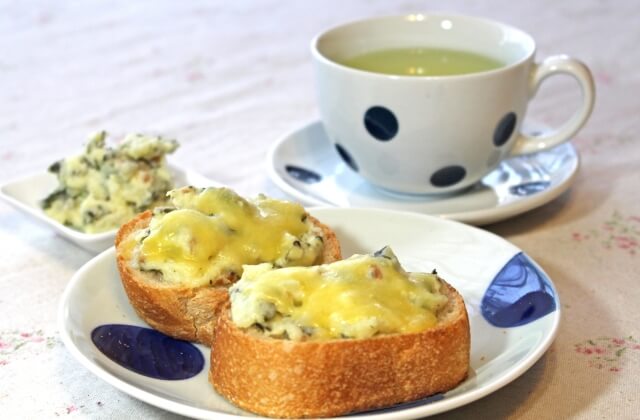 Mashed potatoes with used tea leaves
Mashed potatoes with used tea leaves
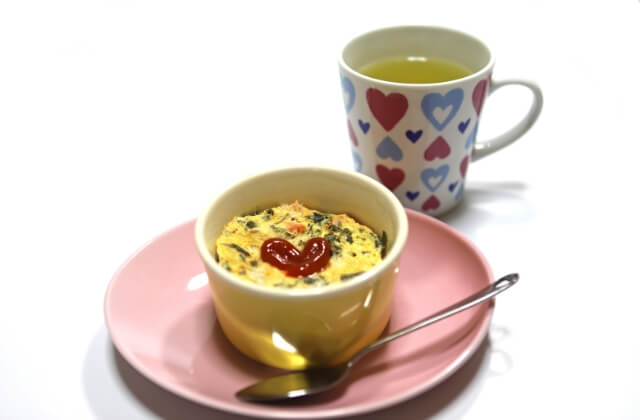 Scrambled egg with used tea leaves
Scrambled egg with used tea leaves
Brewing tea method
FARMER’s recommendation
1. Pour boiled water into a tea pot, then pour the water into a tea cup or mug (about 200 to 220ml). You can warm up the tea pot and cup and cool down the temperature of boiled water (about 85℃) by doing this. The feel of a cup with 85℃ water is such that you can hold the cup somehow. Be careful not to burn yourself.
Sensitivity the hotness is depends on the person or the cup.
2. Use 1 or 1.5 teaspoons of leaf tea (about 3g), and pour the water into the tea pot from the cup.
3. Brew the tea for 3 to 5 minutes. If you like bitterness, brew for 4 or 5 minutes.
4. Pour the tea into the cup.
Try several combinations to find your favorite strength.
You can brew more with the tea leaves as you like.
The brown rice absorbs the water, so some amount of water decreases after brewing.
Mashed potato with used tea leaves
1. Brew GENMAICHA (1 teaspoon/2 to 3g) in 250ml of boiled water.
2. Make mashed potatoes.
3. Mix the used tea leaves and the mashed potato.
Toasting mashed potato with French bread is also delicious.
Place some mashed potato on a piece of French bread and put some cheese on it. Then toast it.
Scrambled egg with used tea leaves after brewing
Mix used tea leaves with an egg and chopped tomato, and put them into a heat-resistant dish ware. Then, heat it at about 800 watts for 1 minute in a microwave. Scrambled egg with used tea leaves is made.
Putting a little squeezed lemon can prevent brown discoloration in used tea leaves.
Drink and eat TEA LEAF and protect Nature
Now people don’t drink much freshly-brewed tea due to emerging cheap tea in plastic bottles. Tea in a plastic bottle is convenient, but use of many plastic bottles is an environmental problem. If you buy and brew their organic tea, at a good price for the tea farmer, it means that you also maintain the environment through the tea farmers.
If you eat used organic tea leaves, you don’t generate food scraps. It is good for the environment, and you can be a part of circular agriculture.
CHAMART creates the recipe for organic tea leaves.
For any inquiry, please contact us.
We can introduce more Organic JAS certified Japanese tea on request.
We will first send an estimate for your request.
Please read our Privacy Policy before sending your inquiry.
If you accept, then please contact us.
Thank you for your understanding.
We look forward to hearing from you.
CHAMART
YUtoMI Solutions Co., Ltd.
E-mail: tea@chamart.jp
Tel: +81(0)90-4401-8774
Address: Kakegawa, Shizuoka, Japan

Medium-steamed green tea from Shizuoka
ORGANIC JAS
CHAGUSABA

Type of tea
Sencha (medium-steamed green tea)
The leaves are steamed for about 40 seconds.
Production place
Shizuoka City, Shizuoka Prefecture, Japan
Producers of tea
A family-run tea garden that manages the production of tea from cultivation through processing.
Leaf
Thin and long, like needles
Color of brewed tea
Clear, pale yellow
Flavor
Fresh and sharp taste with a slight bitterness (mild bitter)
Other
Organic farming (certified Organic JAS *)
○
CHAGUSABA farming method *
△
The tea is cultivated using the CHAGUSABA farming method in non-GIAHS (Globally Important Agricultural Heritage Systems) recognized areas, and the amount of CHAGUSA (grass) for tea fields is small.
*The CHAGUSABA farming method is NOT an organic farming method.
Please refer here for detailed information about this tea, including price, delivery time, MOQ (minimum order quantity), payment, etc.
Please click here for the details of 1, 2, 3 and 4.
1. Organic JAS (Japanese Agricultural Standard)
2. EU Maximum Residue Level (MRL) of Pesticide
3. Examination of Radioactive materials in tea cultivated in Shizuoka Prefecture
4. Tariff rate on green tea to EU and HS code
*CHAGUSABA farming method
A traditional circular agricultural tea farming method “CHAGUSABA” has been conducted primarily in Shizuoka Prefecture for many years.
CHAGUSABA means semi-natural grasslands and CHAGUSA is grass for tea fields. There is much pampas grass, bamboo grass, etc. around the tea fields. Farmers mow the grass and cut them into pieces, then put the cut grass in the furrows between the rows of tea bushes. The grass prevents soil flow & growth of weeds and becomes compost.
The sunlight can reach small flora and fauna because of cutting the grass. Thus, they can continue to live.
Shizuoka’s CHAGUSABA farming method (Traditional Tea-grass Integrated System in Shizuoka) conducted in these four cities (Kakegawa, Kikugawa, Makinohara and Shimada) and one town (Kawanehon) in Shizuoka Prefecture was recognized as a Globally Important Agricultural Heritage System (GIAHS) by the Food and Agriculture Organization of the United Nations (FAO) in 2013. However, the CHAGUSABA farming method has been conducted in some places other than these five locations in Shizuoka Prefecture and in some other prefectures of Japan as well.
*Tea leaves contain caffeine. The diuretic, stimulant and anticancer effects of caffeine intake are clinically recognized. On the other hand, excessive intake of caffeine may have a damaging effect on health. Especially, pregnant or breastfeeding women, and children should be careful with the amount of caffeine they intake.
Reference:
Traditional Tea-grass Integrated System in Shizuoka
GIAHS Globally Important Agricultural Heritage Systems
Food and Agriculture Organization of the United Nations
http://www.fao.org/giahs/giahsaroundtheworld/designated-sites/asia-and-the-pacific/traditional-tea-grass-integrated-system-in-shizuoka/en/
農林水産省 カフェインの過剰摂取について
https://www.maff.go.jp/index.html
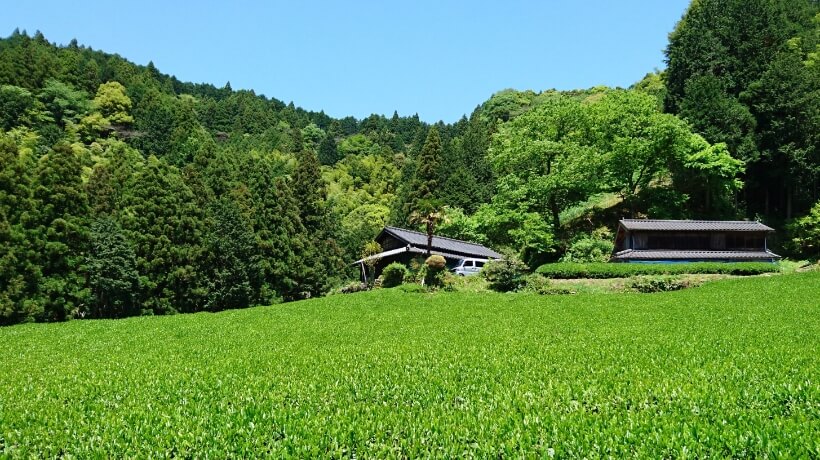
Shizuoka Prefecture is a representative tea production area of Japan, located in the center of the main island of Japan. Shizuoka Prefecture has a warm climate with many rivers and is often foggy. These conditions are suitable for tea cultivation. Shiuoka City is one of the major tea production cities in Shizuoka Prefecture.
There are many facilities related to tea such as tea museums, a hotel with a tea theme, etc. in Shizuoka Prefecture.
A family-run tea garden that manages the production of tea from cultivation through processing.
The family is cultivating tea upstream. There are clear streams and rivers, and fog is generated often in their region. The temperature difference between day and night is extreme. This contributes to producing a good tea.
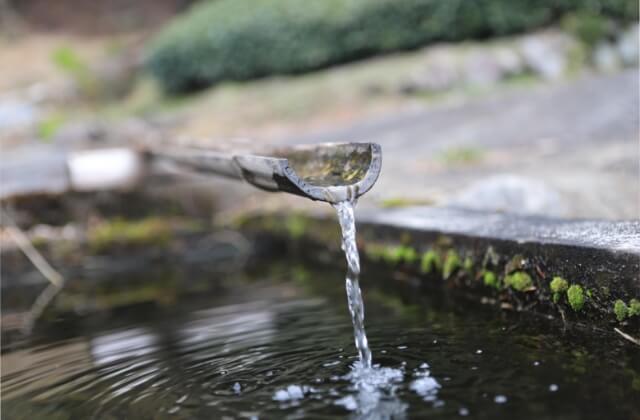 Spring water comes out from the mountain at the location. Their philosophy is “Don’t pollute water, conserve the mountains” and it is a responsibility as a farmer who cultivates tea upstream.
Spring water comes out from the mountain at the location. Their philosophy is “Don’t pollute water, conserve the mountains” and it is a responsibility as a farmer who cultivates tea upstream.

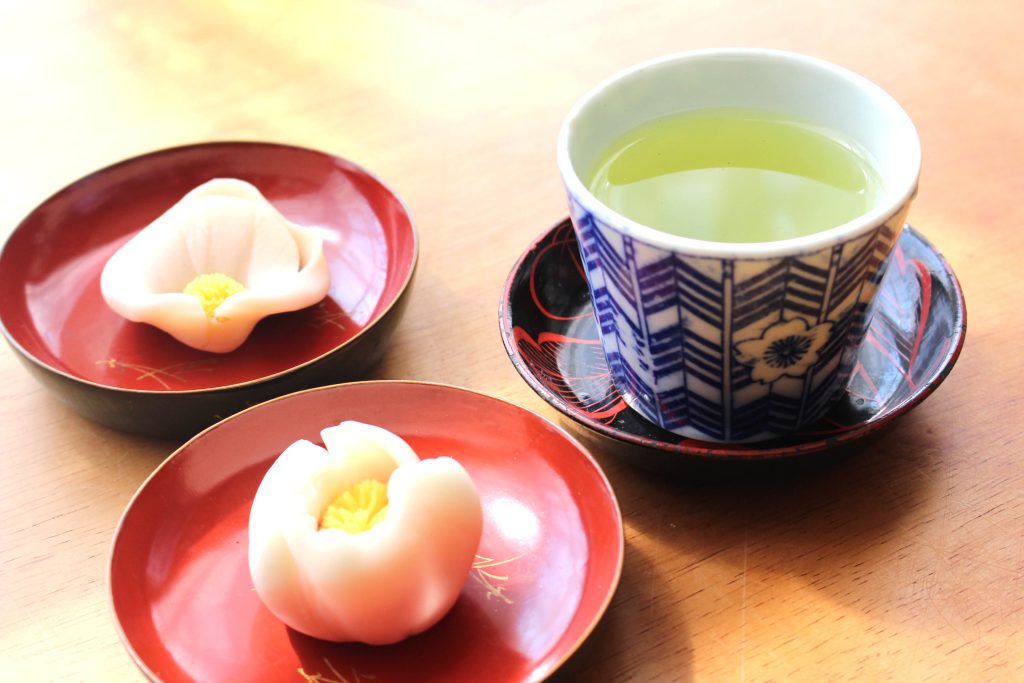
 Pizza using the used tea leaves of sencha[/caption]
Pizza using the used tea leaves of sencha[/caption]Drink and eat TEA LEAF and protect Nature
Now people don’t drink much freshly-brewed tea due to emerging cheap tea in plastic bottles. Tea in a plastic bottle is convenient, but use of many plastic bottles is an environmental problem. If you buy and brew their organic tea, at a good price for the tea farmer, it means that you also maintain the environment through the tea farmers.
If you eat used organic tea leaves, you don’t generate food scraps. It is good for the environment, and you can be a part of circular agriculture.
For any inquiry, please contact us.
We can introduce more Organic JAS certified Japanese tea on request.
We will first send an estimate for your request.
Please read our Privacy Policy before sending your inquiry.
If you accept, then please contact us.
Thank you for your understanding.
We look forward to hearing from you.
CHAMART
YUtoMI Solutions Co., Ltd.
E-mail: tea@chamart.jp
Tel: +81(0)90-4401-8774
Address: Kakegawa, Shizuoka, Japan

Three-year aged roasted green tea from Kakegawa
ORGANIC JAS
CHAGUSABA

Type of tea
Sannen-bancha (three-year aged bancha)
Production place
Kakegawa City, Shizuoka Prefecture, Japan
Producers of tea
A family-run tea garden that manages the production of tea from cultivation through processing.
Leaf
Stem with leaf, roasted and slightly hard
Color of brewed tea
Dark brown
Flavor
Mild roasted and bitter with a slight acid taste
Other
The flavor of sannen-bancha is similar to hojicha, but it is different from hojicha. Sannen-bancha has a mild roasted flavor with a subtle acidity. The roasted flavor is not strong like hojicha.
The tea leaves and stems are stored and matured for three years, which reduces stimulatory components such as caffeine or tannins and makes a mellow flavor.
Organic farming (certified Organic JAS *)
○
CHAGUSABA farming method *
○
The tea is cultivated using the CHAGUSABA farming method in GIAHS (Globally Important Agricultural Heritage Systems) recognized areas.
*The CHAGUSABA farming method is NOT an organic farming method.
Please refer here for detailed information about this tea, including price, delivery time, MOQ (minimum order quantity), payment, etc.
Please click here for the details of 1, 2, 3 and 4.
1. Organic JAS (Japanese Agricultural Standard)
2. EU Maximum Residue Level (MRL) of Pesticide
3. Examination of Radioactive materials in tea cultivated in Shizuoka Prefecture
4. Tariff rate on green tea to EU and HS code
*CHAGUSABA farming method
A traditional circular agricultural tea farming method “CHAGUSABA” has been conducted primarily in Shizuoka Prefecture for many years.
CHAGUSABA means semi-natural grasslands and CHAGUSA is grass for tea fields. There is much pampas grass, bamboo grass, etc. around the tea fields. Farmers mow the grass and cut them into pieces, then put the cut grass in the furrows between the rows of tea bushes. The grass prevents soil flow & growth of weeds and becomes compost.
The sunlight can reach small flora and fauna because of cutting the grass. Thus, they can continue to live.
Shizuoka’s CHAGUSABA farming method (Traditional Tea-grass Integrated System in Shizuoka) conducted in these four cities (Kakegawa, Kikugawa, Makinohara and Shimada) and one town (Kawanehon) in Shizuoka Prefecture was recognized as a Globally Important Agricultural Heritage System (GIAHS) by the Food and Agriculture Organization of the United Nations (FAO) in 2013. However, the CHAGUSABA farming method has been conducted in some places other than these five locations in Shizuoka Prefecture and in some other prefectures of Japan as well.
*Tea leaves contain caffeine. The diuretic, stimulant and anticancer effects of caffeine intake are clinically recognized. On the other hand, excessive intake of caffeine may have a damaging effect on health. Especially, pregnant or breastfeeding women, and children should be careful with the amount of caffeine they intake.
Reference:
Traditional Tea-grass Integrated System in Shizuoka
GIAHS Globally Important Agricultural Heritage Systems
Food and Agriculture Organization of the United Nations
http://www.fao.org/giahs/giahsaroundtheworld/designated-sites/asia-and-the-pacific/traditional-tea-grass-integrated-system-in-shizuoka/en/
農林水産省 カフェインの過剰摂取について
https://www.maff.go.jp/index.html

Kakegawa is one of the famous tea production areas in Japan, and has many tea fields in flat land and in mountain areas. The cancer mortality rate of Kakegawa City is the lowest among cities in Japan with populations over 100,000. It is said that people drink a lot of tea in a day, and it may be related to that fact.
Kakegawa City has conducted a study in its city that investigated the connection between green tea and effects of improving life style related diseases.
The tea is cultivated using CHAGUSABA farming method.
The CHAGUSABA farming method has been conducted for many years at several locations in Kakegawa City. The CHAGUSABA farming method is a circular agriculture that maintains the environment around tea fields and is recognized as a Globally Important Agricultural Heritage System (GHIAS) by the Food and Agriculture Organization (FAO) of the United Nations.
CHAGUSABA means semi-natural grasslands around tea fields and CHAGUSA means the grasses for the tea fields.
 CHAGUSA in the tea field
CHAGUSA in the tea field
The tea garden was established in 1915. The philosophy of the tea garden is respect for nature and cultivating tea. These tea farmers do not want to destroy the ecosystem using agricultural chemicals. Thus, they work to make a rich soil using many microscopic organisms and organic compost. If they encounter a problem or difficulty, for example harmful insects, they observe the tea fields and the environment carefully to find a solution. The owner of the tea garden says that it is important to observe the tea fields daily. The owner and staff are always trying to find new methods of cultivating as well as improving tea processing machines in order to make a good tea.
They make various types of tea such as matcha, fukamushicha (deep-steamed green tea), wakocha (Japanese black tea), hojicha (green tea which is steamed and roasted), kukicha (steamed green tea with stems), genmaicha, etc..
They provide a place where people can enjoy their tea and a chance for children to have an experience picking tea leaves to learn about tea. They also contribute to the local community through tea.
 Making nutrient rich soil with CHAGUSA and rice bran
Making nutrient rich soil with CHAGUSA and rice bran
 Putting the soil into the tea field
Putting the soil into the tea field
Sannen-bancha leaf can be used for various purposes not only for drinking, but also for French onion soup, etc.

Sannen-bancha can be compared to a fine aged wine, and is especially enjoyed served in a wine glass.
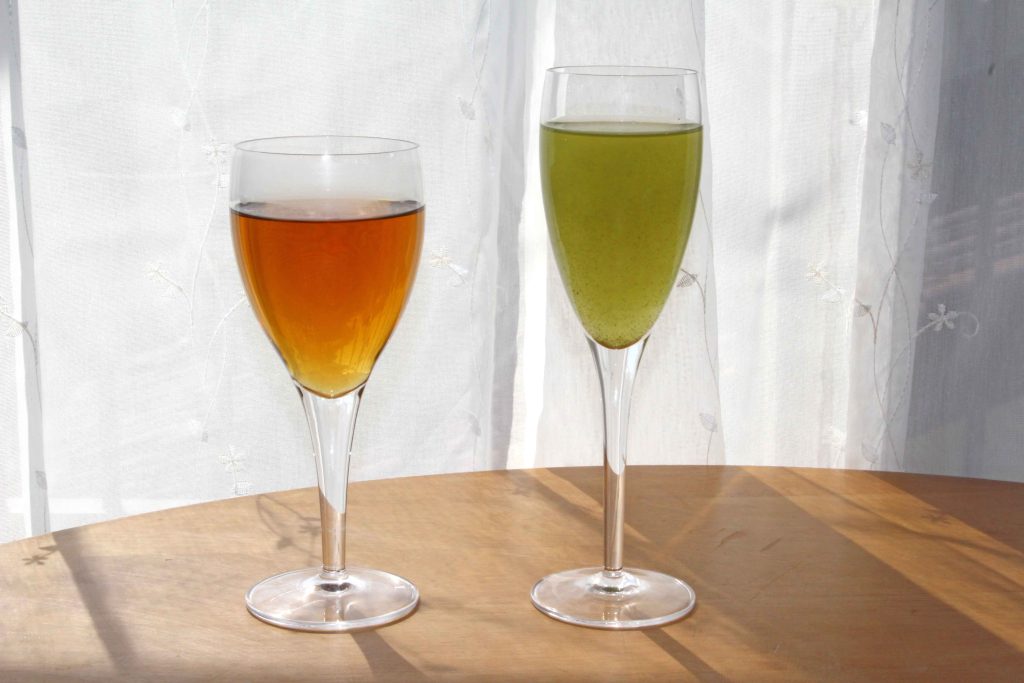 Left: Three-year aged bancha, right: Fukamushicha
Left: Three-year aged bancha, right: Fukamushicha
 French onion soup using Three-year aged bancha
French onion soup using Three-year aged bancha
For any inquiry, please contact us.
We can introduce more organic JAS certified Japanese tea on request.
We will first send an estimate for your request.
Please read our Privacy Policy before sending your inquiry.
If you accept, then please contact us.
Thank you for your understanding.
We look forward to hearing from you.
CHAMART
YUtoMI Solutions Co., Ltd.
E-mail: tea@chamart.jp
Tel: +81(0)90-4401-8774
Address: Kakegawa, Shizuoka, Japan
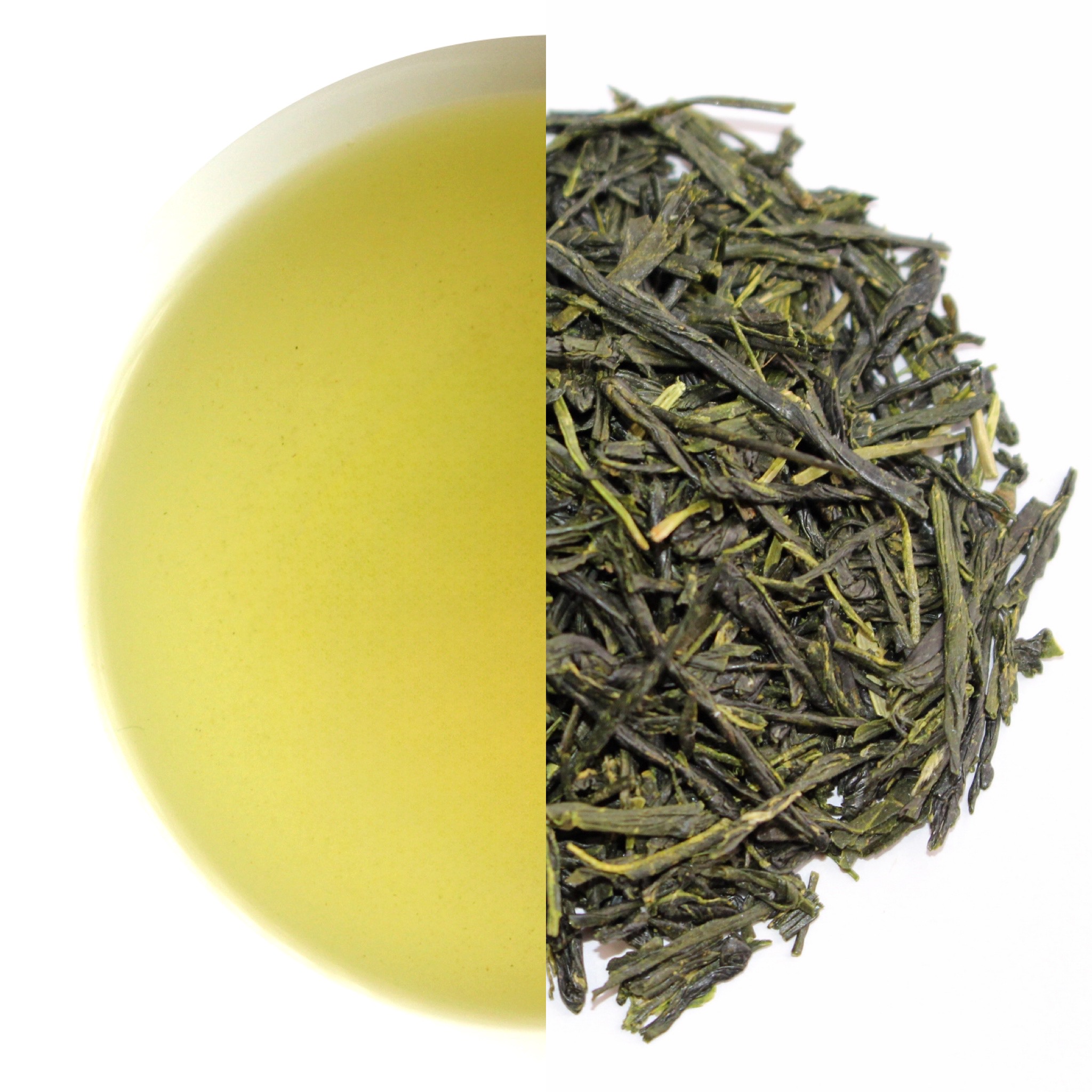
High-grade steamed green tea from Shizuoka
ORGANIC JAS
CHAGUSABA
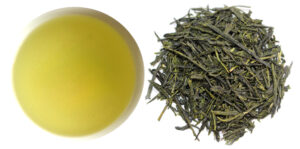
Type of tea
Hon-gyokuro (premium grade steamed green tea)
Production place
Shizuoka City, Shizuoka Prefecture, Japan
Producers of tea
A family-run tea garden that manages the production of tea from cultivation through processing.
Leaf
Thin and long, like needles
Color of brewed tea
Clear, pale yellow
Flavor
Rich and pronounced umami. Velvety, deep satisfying and full-bodied.
Other
Gyokuro (玉露) is a high-grade green tea and its name means “jewel dew” or “jade dew”. Before picking the tea leaves, the gyokuro tea garden is covered with kanreisha (寒冷紗), komo (菰), or yoshizu (葦簀) for approximately three weeks. Kanreisha is a man-made black cloth, while komo and yoshizu are straw mats. Gyokro use only new shoots. By covering the tea garden to block sunlight, catechins which are a component of bitterness, is suppressed, while amino acids, which are components of umami, are increased.
CHAMART introduces Hon-gyokuro (本玉露), a premium grade of gyokuro.
Hon-gyokuro requires additional care. Poles are installed to support the kanreisha, komo, or yoshizu, ensuring that these coverings do not directly touch the tea plants. Furthermore, only tender new shoots that have been hand-picked are used for Hon-gyokuro.
CHAMART’s Hon-gyokuro is covered with kanreisha using poles for approximately one month and is made using hand-picked tea leaves.
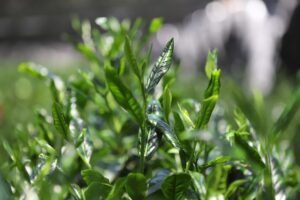
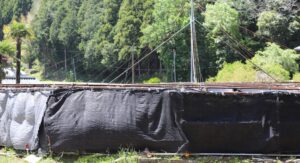
Cultivation & processing
Tea plants are grown in their natural bush formation (自然仕立て).
Organic farming (certified Organic JAS *)
○
CHAGUSABA farming method *
○
The tea is cultivated using the CHAGUSABA farming method in Shizuoka City. The amount of CHAGUSA (grass) for tea fields is plentiful. Shizuoka City was NOT the area certified as a Globally Important Agricultural Heritage System (GIAHS) by the Food and Agriculture Organization of the United Nations (FAO) in 2013.
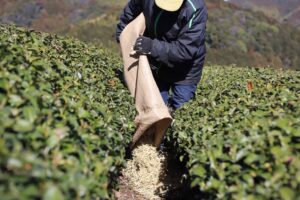
Please refer here for detailed information about this tea, including price, delivery time, MOQ (minimum order quantity), payment, etc.
Please click here for the details of 1, 2, 3 and 4.
1. Organic JAS (Japanese Agricultural Standard)
2. EU Maximum Residue Level (MRL) of Pesticide
3. Examination of Radioactive materials in tea cultivated in Shizuoka Prefecture
4. Tariff rate on green tea to EU and HS code
*CHAGUSABA farming method
A traditional circular agricultural tea farming method “CHAGUSABA” has been conducted primarily in Shizuoka Prefecture for many years.
CHAGUSABA means semi-natural grasslands and CHAGUSA is grass for tea fields. There is much pampas grass, bamboo grass, etc. around the tea fields. Farmers mow the grass and cut them into pieces, then put the cut grass in the furrows between the rows of tea bushes. The grass prevents soil flow & growth of weeds and becomes compost.
The sunlight can reach small flora and fauna because of cutting the grass. Thus, they can continue to live.
Shizuoka’s CHAGUSABA farming method (Traditional Tea-grass Integrated System in Shizuoka) conducted in these four cities (Kakegawa, Kikugawa, Makinohara and Shimada) and one town (Kawanehon) in Shizuoka Prefecture was recognized as a Globally Important Agricultural Heritage System (GIAHS) by the Food and Agriculture Organization of the United Nations (FAO) in 2013. However, the CHAGUSABA farming method has been conducted in some places other than these five locations in Shizuoka Prefecture and in some other prefectures of Japan as well.
*Tea leaves contain caffeine. The diuretic, stimulant and anticancer effects of caffeine intake are clinically recognized. On the other hand, excessive intake of caffeine may have a damaging effect on health. Especially, pregnant or breastfeeding women, and children should be careful with the amount of caffeine they intake.
Reference:
Traditional Tea-grass Integrated System in Shizuoka
GIAHS Globally Important Agricultural Heritage Systems
Food and Agriculture Organization of the United Nations
http://www.fao.org/giahs/giahsaroundtheworld/designated-sites/asia-and-the-pacific/traditional-tea-grass-integrated-system-in-shizuoka/en/
農林水産省 カフェインの過剰摂取について
https://www.maff.go.jp/index.html
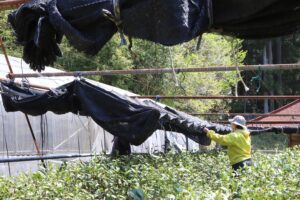
Shizuoka Prefecture is a representative tea production area of Japan, located in the center of the main island of Japan. Shizuoka Prefecture has a warm climate with many rivers and is often foggy. These conditions are suitable for tea cultivation. Shiuoka City is one of the major tea production cities in Shizuoka Prefecture.
There are many facilities related to tea such as tea museums, a hotel with a tea theme, etc. in Shizuoka Prefecture.
A family-run tea garden that manages the production of tea from cultivation through processing. The family cultivates tea upstream, where clear streams and rivers flow, and fog is often generated in their region. The temperature difference between day and night is extreme, contributing to the production of good tea. They produce tea while living in harmony with nature. Their philosophy is not to pollute the water and soil; to conserve the mountains, which they see as their responsibility as farmers cultivating tea upstream.
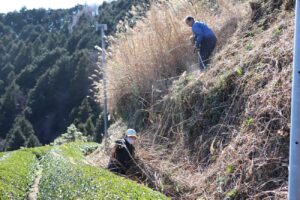
To fully appreciate its unique character, drink it slowly, little by little, savoring both its special flavor and the delicate tea leaves. The used tea leaves remain soft and can be enjoyed as a salad with olive oil or tomato.
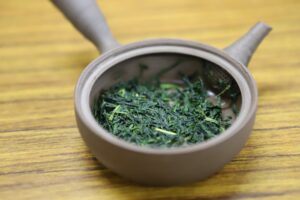
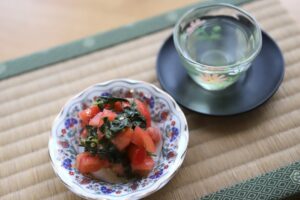
Salad of used tea leaves with olive oil and tomato
Drink and eat TEA LEAF and protect Nature
Now people don’t drink much freshly-brewed tea due to emerging cheap tea in plastic bottles. Tea in a plastic bottle is convenient, but use of many plastic bottles is an environmental problem. If you buy and brew their organic tea, at a good price for the tea farmer, it means that you also maintain the environment through the tea farmers.
If you eat used organic tea leaves, you don’t generate food scraps. It is good for the environment, and you can be a part of circular agriculture.
CHAMART creates the recipes with used tea leaves.
For any inquiry, please contact us.
We can introduce more organic JAS certified Japanese tea on request.
We will first send an estimate for your request.
Please read our Privacy Policy before sending your inquiry.
If you accept, then please contact us.
Thank you for your understanding.
We look forward to hearing from you.
CHAMART
YUtoMI Solutions Co., Ltd.
E-mail: tea@chamart.jp
Tel: +81(0)90-4401-8774
Address: Kakegawa, Shizuoka, Japan

Naturally fragrant medium steamed green tea from Shizuoka
ORGANIC JAS
CHAGUSABA
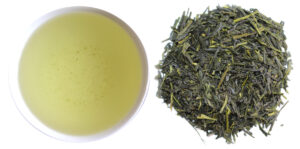
The sencha has a natural aroma reminiscent of cherry blossom leaves. This sencha is blended with varieties of Yabukita and Shizu 7132.
Type of tea
Sencha (medium-steamed green tea)
The leaves are steamed for about 40 seconds.
Production place
Shizuoka City, Shizuoka Prefecture, Japan
Producers of tea
A family-run tea garden that manages the production of tea from cultivation through processing.
Leaf
Thin and long, like needles
Color of brewed tea
Clear, pale yellow
Flavor
A delicate natural fragrance of cherry blossom leaves, gentle sweetness, moderate umami, and a hint of velvety smoothness
Other
Organic farming (certified Organic JAS *)
○
CHAGUSABA farming method *
△
The tea is cultivated using the CHAGUSABA farming method in Shizuoka City. However, Shizuoka City was not the area certified as a Globally Important Agricultural Heritage System (GIAHS) by the Food and Agriculture Organization of the United Nations (FAO) in 2013. In addition, the amount of CHAGUSA (grass) for tea fields is small.
*The CHAGUSABA farming method is NOT an organic farming method.
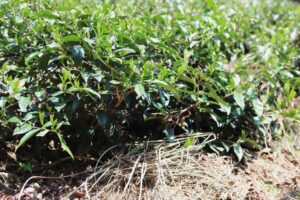
Please refer here for detailed information about this tea, including price, delivery time, MOQ (minimum order quantity), payment, etc.
Please click here for the details of 1, 2, 3 and 4.
1. Organic JAS (Japanese Agricultural Standard)
2. EU Maximum Residue Level (MRL) of Pesticide
3. Examination of Radioactive materials in tea cultivated in Shizuoka Prefecture
4. Tariff rate on green tea to EU and HS code
*CHAGUSABA farming method
A traditional circular agricultural tea farming method “CHAGUSABA” has been conducted primarily in Shizuoka Prefecture for many years.
CHAGUSABA means semi-natural grasslands and CHAGUSA is grass for tea fields. There is much pampas grass, bamboo grass, etc. around the tea fields. Farmers mow the grass and cut them into pieces, then put the cut grass in the furrows between the rows of tea bushes. The grass prevents soil flow & growth of weeds and becomes compost.
The sunlight can reach small flora and fauna because of cutting the grass. Thus, they can continue to live.
Shizuoka’s CHAGUSABA farming method (Traditional Tea-grass Integrated System in Shizuoka) conducted in these four cities (Kakegawa, Kikugawa, Makinohara and Shimada) and one town (Kawanehon) in Shizuoka Prefecture was recognized as a Globally Important Agricultural Heritage System (GIAHS) by the Food and Agriculture Organization of the United Nations (FAO) in 2013. However, the CHAGUSABA farming method has been conducted in some places other than these five locations in Shizuoka Prefecture and in some other prefectures of Japan as well.
*Tea leaves contain caffeine. The diuretic, stimulant and anticancer effects of caffeine intake are clinically recognized. On the other hand, excessive intake of caffeine may have a damaging effect on health. Especially, pregnant or breastfeeding women, and children should be careful with the amount of caffeine they intake.
Reference:
Traditional Tea-grass Integrated System in Shizuoka
GIAHS Globally Important Agricultural Heritage Systems
Food and Agriculture Organization of the United Nations
http://www.fao.org/giahs/giahsaroundtheworld/designated-sites/asia-and-the-pacific/traditional-tea-grass-integrated-system-in-shizuoka/en/
農林水産省 カフェインの過剰摂取について
https://www.maff.go.jp/index.html

Shizuoka Prefecture is a representative tea production area of Japan, located in the center of the main island of Japan. Shizuoka Prefecture has a warm climate with many rivers and is often foggy. These conditions are suitable for tea cultivation. Shiuoka City is one of the major tea production cities in Shizuoka Prefecture.
There are many facilities related to tea such as tea museums, a hotel with a tea theme, etc. in Shizuoka Prefecture.
A family-run tea garden that manages the production of tea from cultivation through processing.
The family is cultivating tea upstream. There are clear streams and rivers, and fog is generated often in their region. The temperature difference between day and night is extreme. This contributes to producing a good tea.
 Spring water comes out from the mountain at the location. Their philosophy is “Don’t pollute water, conserve the mountains” and it is a responsibility as a farmer who cultivates tea upstream.
Spring water comes out from the mountain at the location. Their philosophy is “Don’t pollute water, conserve the mountains” and it is a responsibility as a farmer who cultivates tea upstream.
There are various ways to enjoy Sencha. Sencha is great for drinking, but it can also be used in cooking. The used tea leaves remain soft and can be enjoyed in dishes like pasta, salad, etc.


Drink and eat TEA LEAF and protect Nature
Now people don’t drink much freshly-brewed tea due to emerging cheap tea in plastic bottles. Tea in a plastic bottle is convenient, but use of many plastic bottles is an environmental problem. If you buy and brew their organic tea, at a good price for the tea farmer, it means that you also maintain the environment through the tea farmers.
If you eat used organic tea leaves, you don’t generate food scraps. It is good for the environment, and you can be a part of circular agriculture.
For any inquiry, please contact us.
We can introduce more organic JAS certified Japanese tea on request.
We will first send an estimate for your request.
Please read our Privacy Policy before sending your inquiry.
If you accept, then please contact us.
Thank you for your understanding.
We look forward to hearing from you.
CHAMART
YUtoMI Solutions Co., Ltd.
E-mail: tea@chamart.jp
Tel: +81(0)90-4401-8774
Address: Kakegawa, Shizuoka, Japan
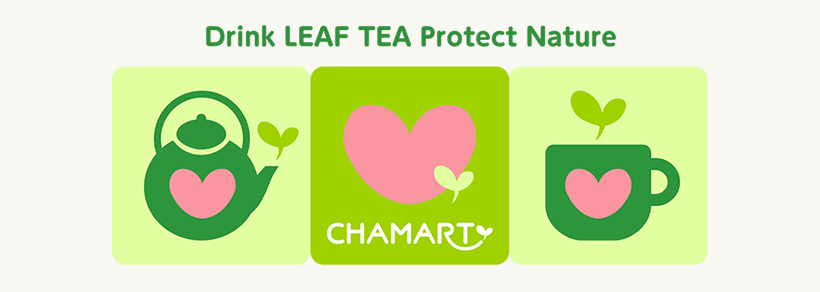
CHAMART introduces and connects local tea farmers, tea sellers, tea shops and tea tourism to the world. CHAMART knows many good quality teas, tea farmers, tea sellers, tea shops, tea tourism and has the knowledge about JAPANESE TEA. Although CHAMART does not have its own tea fields and factory, CHAMART can introduce good tea for your health and the environment and respond to your requests about JAPANESE TEA.
CHAMART is run by YUtoMI Solutions Co., Ltd. YUtoMI Solutions Co., Ltd. provides the services of English/Japanese translation & interpretation, English lesson, coordination about tea between Japan and overseas, etc..
www.eigohelpers.com/english/
For any inquiry and question about tea, please contact us.
Please read our Privacy Policy before you contact us.
If you accept, then please contact us.
CHAMART
YUtoMI Solutions Co., Ltd.
Skype: CHAMARTtea
Tel: +81(0)90-4401-8774
Address: Kakegawa, Shizuoka, Japan
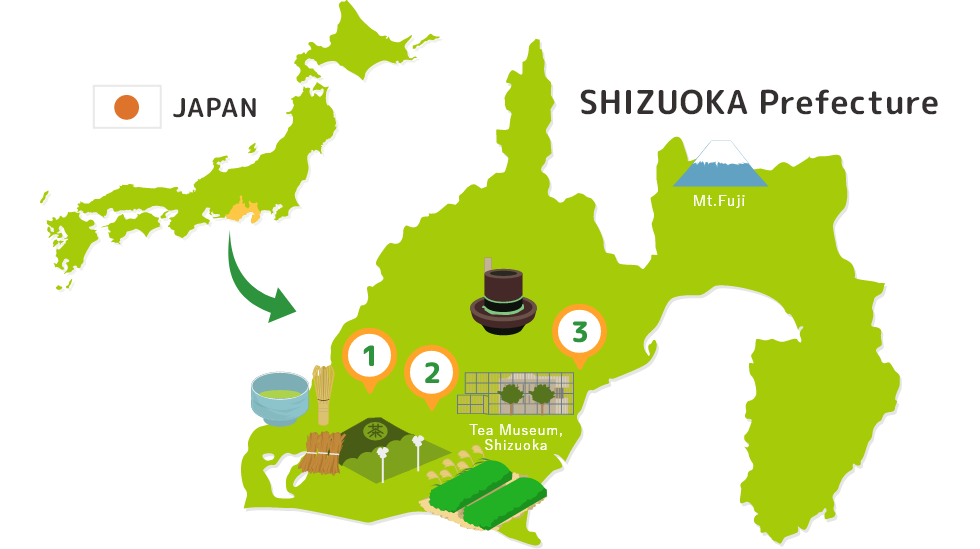
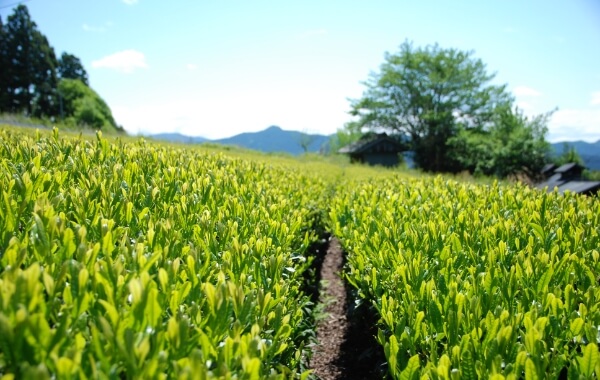
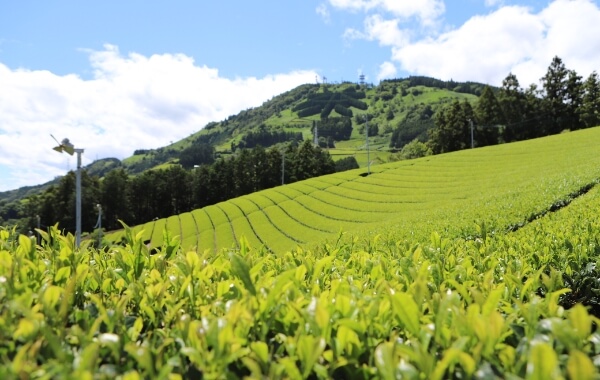
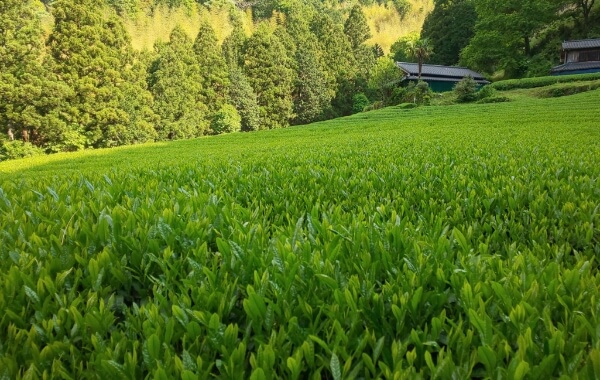
SHIZUOKA Prefecture is the top producer of tea in Japan. There are many places where tea is produced such as Kakegawa City, Shizuoka City, etc. and SHIZUOKA Prefecture produces many types of tea, such as SENCHA (medium-steamed green tea), FUKAMUSHICHA (deep-steamed green tea), MATCHA (special quality powdered green tea), HOJICHA (roasted green tea), GYOKURO (special quality steamed green tea), KUKICHA (steamed green tea with stems), KABUSECHA (quality steamed green tea) and WAKOCHA (Japanese black tea).

There are many rivers and mountains that generate fog, and the hours of sunlight in a day are long in SHIZUOKA Prefecture. It means that there are pure air and water, fog, and sunlight that are needed for cultivating a good tea in SHIZUOKA Prefecture.
There are many attractive places about tea in Japan to visit. You can especially enjoy “TEA tourism” in SHIZUOKA Prefecture. There is the “Tea Museum, Shizuoka,” Chamonji (the Chinese character “茶“ (TEA) is formed with about 1,000 hinoki cypresses and its longitudinal/lateral size is 130m each) on Mt. Awagatake, hotels themed on tea, tea farm inns, Japanese tea ceremony rooms, tea café, and tea shops. You can experience a Japanese tea ceremony, CHAGUSABA farming method, plucking tea leaves, making Japanese tea, a picnic in the tea fields, and more.
SHIZUOKA Prefecture is located in the center of Japan. In addition, there is Mt. Fuji Shizuoka Airport which connects with China, Korea and Taiwan, and many JR Shinkansen (bullet train) stations in SHIZUOKA Prefecture. SHIZUOKA Prefecture is a convenient place to access from overseas.
Click here for more information of CHAGUSABA tour.
Movie about CHAGUSABA tour

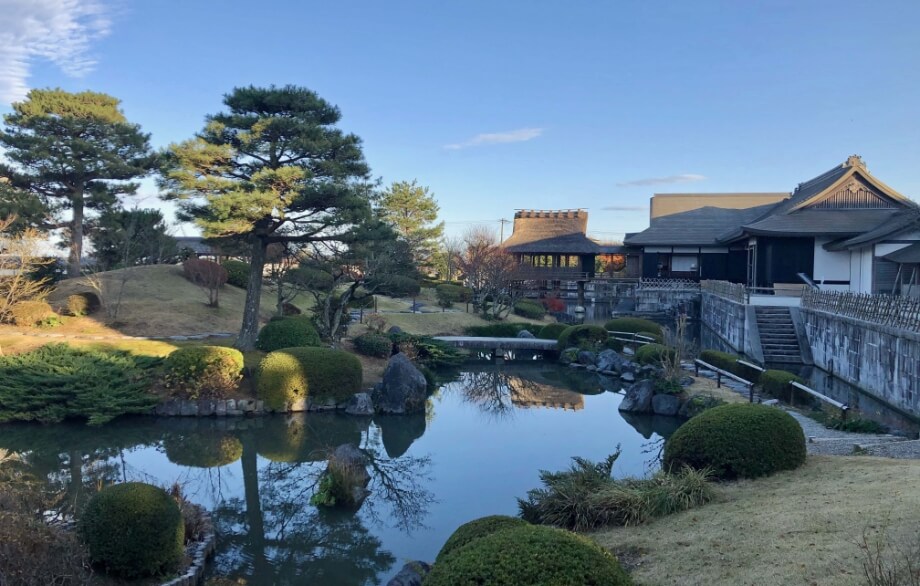
Tea Museum Shizuoka
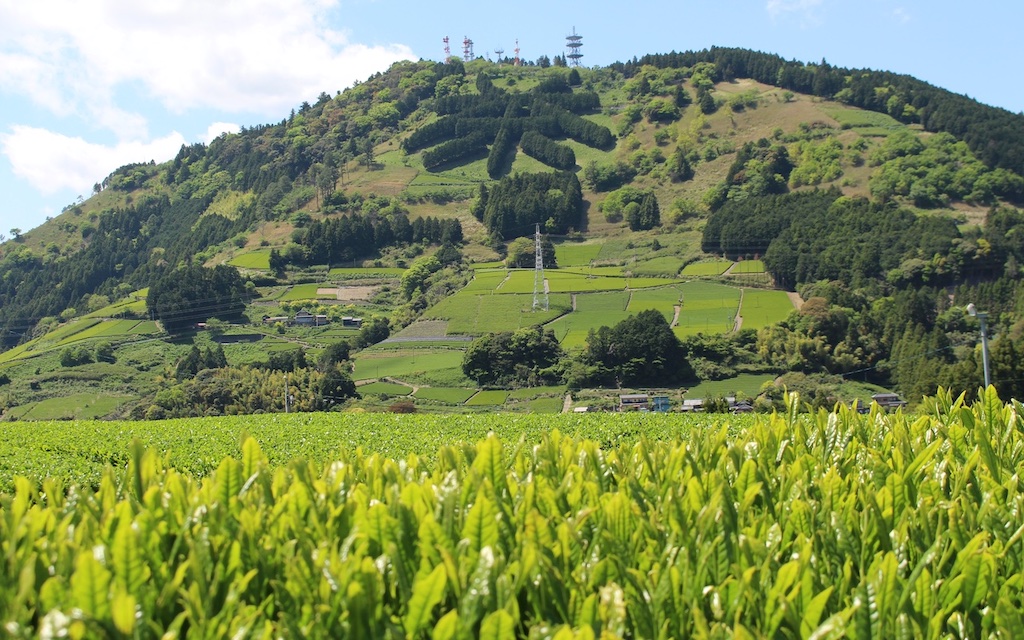
Chamonji on Mt. Awagatake
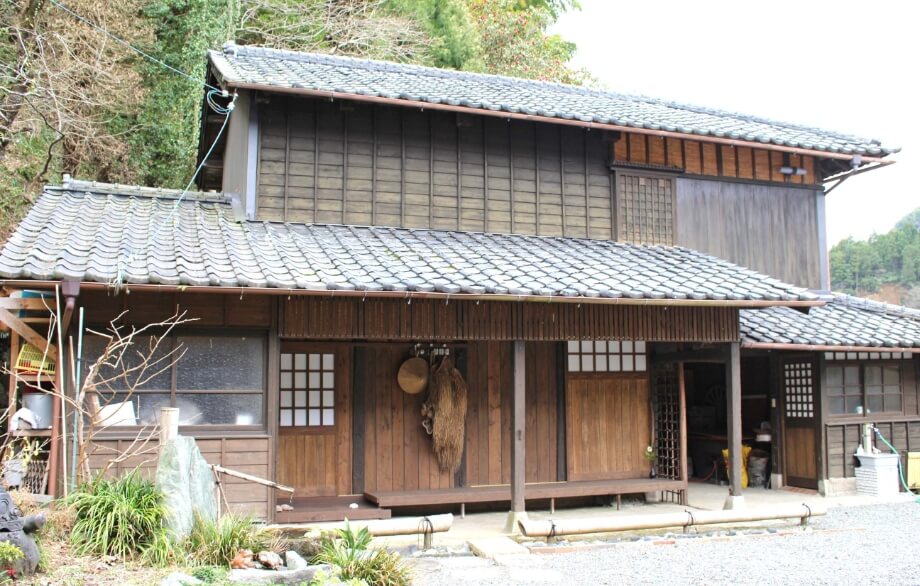
Tea farm inn Nukumorien Yururi
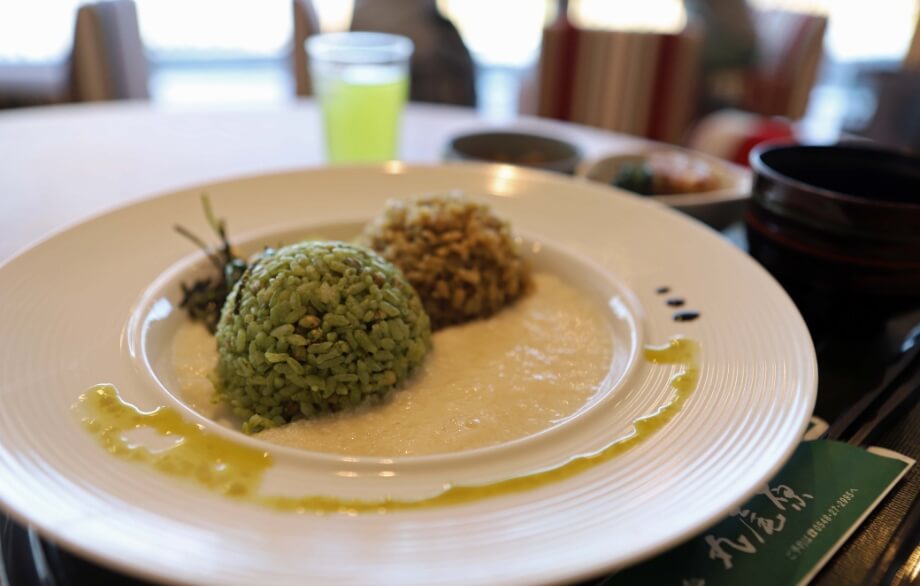
MATCHA/HOJICHA rice at Tea restaurant & cafe Maruobara, in Tea Museum Shizuoka
CHA (茶) means tea and CHAGUSABA (茶草場) means semi-natural grasslands around tea fields, and CHAGUSA (茶草) is grass for tea fields.
A traditional tea farming method “CHAGUSABA” has been conducted primarily in Shizuoka Prefecture for many years. Shizuoka’s CHAGUSABA farming method (Traditional Tea-grass Integrated System in Shizuoka) conducted in these four cities (Kakegawa, Kikugawa, Makinohara and Shimada) and one town (Kawanehon) in Shizuoka Prefecture was recognized as a Globally Important Agricultural Heritage System (GIAHS) by the Food and Agriculture Organization of the United Nations (FAO) in 2013.
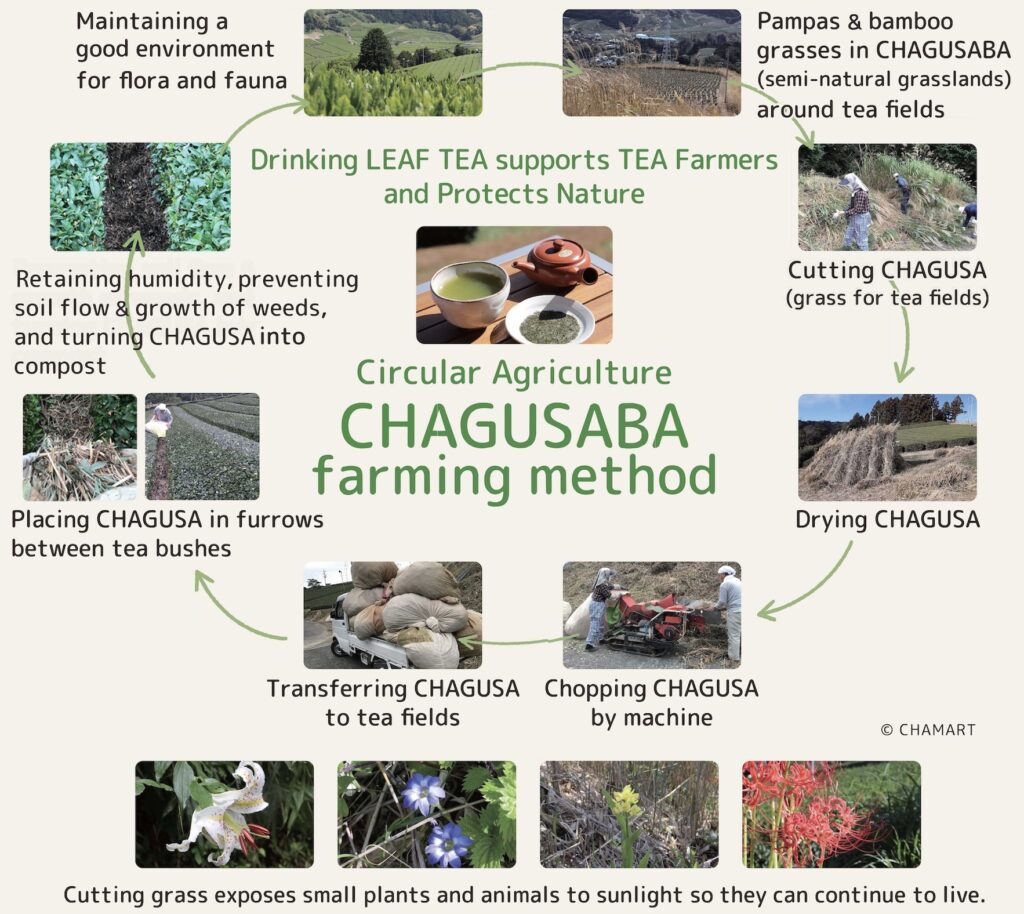
The CHAGUSABA farming method has been conducted in some places other than these five locations in Shizuoka Prefecture and in some other prefectures of Japan as well.
CHAMART will introduce both CHAGUSABA TEAs cultivated in GIAHS recognized areas, some grown in other areas, and also non-CHAGUSABA TEAs at the trade fair.
There are some farmers who cultivate tea using both the CHAGUSABA farming method and organic farming methods. However, the CHAGUSABA farming method is not an organic farming method.
For further details of the CHAGUSABA farming method, please see the pages below;
Related article on the site “Traditional Tea-grass Integrated System in Shizuoka (CHAGUSABA farming method)”
https://chamart.jp/en/archives/learn_heritage/shizuoka_chagusaba/
Traditional Tea-grass Integrated System in Shizuoka, FAO
http://www.fao.org/giahs/giahsaroundtheworld/designated-sites/asia-and-the-pacific/traditional-tea-grass-integrated-system-in-shizuoka/en/
Globally Important Agricultural Heritage Systems (GIAHS), FAO
http://www.fao.org/giahs/en/
世界農業遺産 静岡の茶草場農法 GIAHS “CHAGUSABA” in Shizuoka
https://www.chagusaba.jp
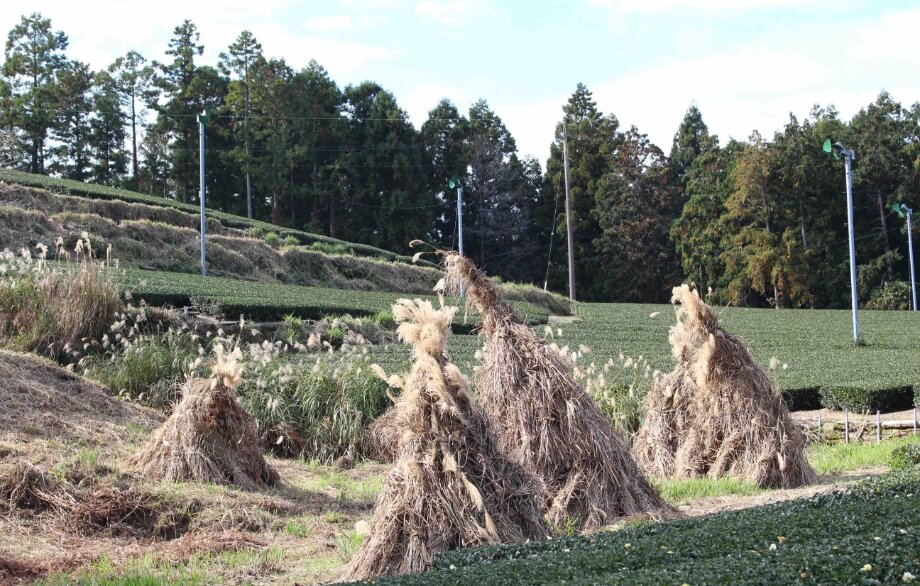
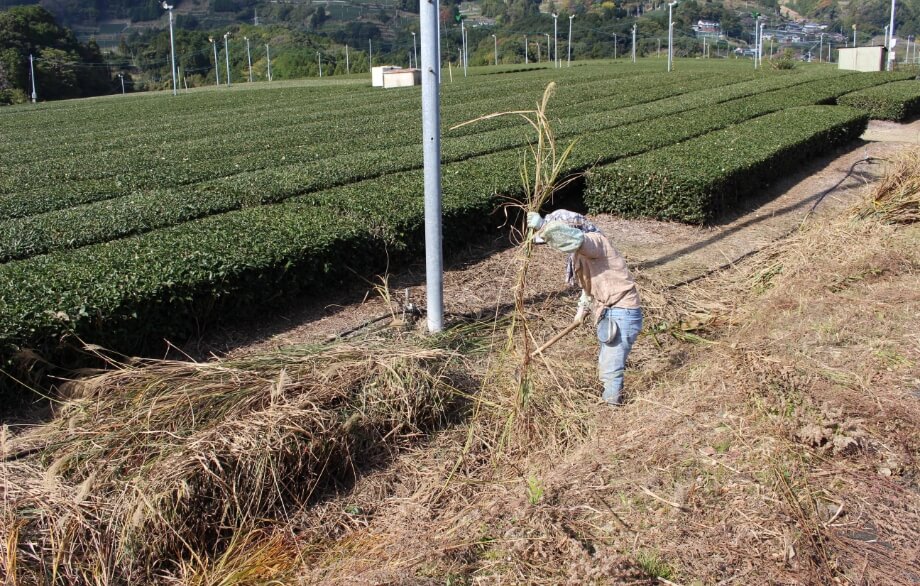
There are many components in GREEN TEA, including JAPANESE GREEN TEA, which have health and beauty benefits.
These benefits are scientifically proven.
Catechins
Catechins
Theanine
Catechins
Polysaccharides
Catechins
Vitamin B and E
Catechins
Vitamin C
Shizuoka Prefecture. Leaflet “SHIZUOKA GREEN TEA
Japan Tea Central Republic Interest Incorporated Association (2013).
Cha no kinō, Translated as SCIENTIFIC EVIDENCE FOR THE HEALTH BENEFITS OF GREEN TEA
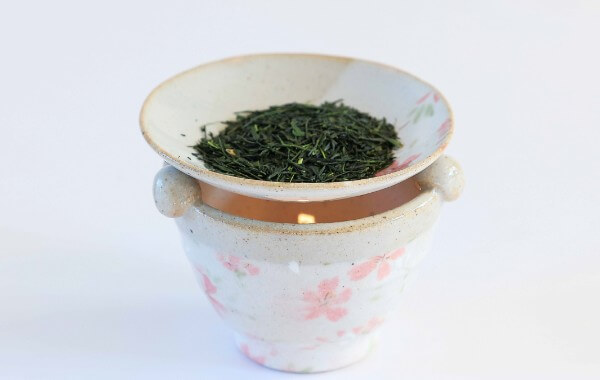
Tea incense burner

Dyeing cloth with tea
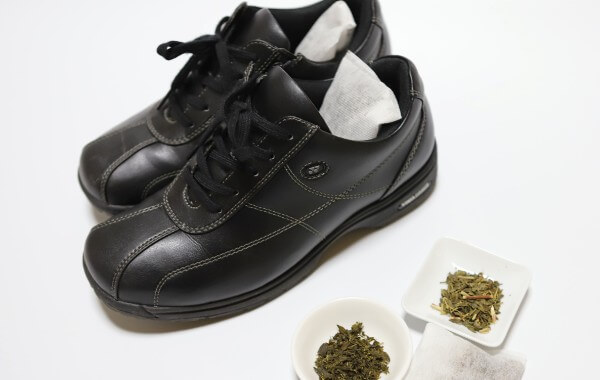
Old or dried, used tea leaves can be used as a deodorizer for shoes.
The tea dust for dyeing the products on the site is different from the teas CHAMART will introduce at the trade fair.
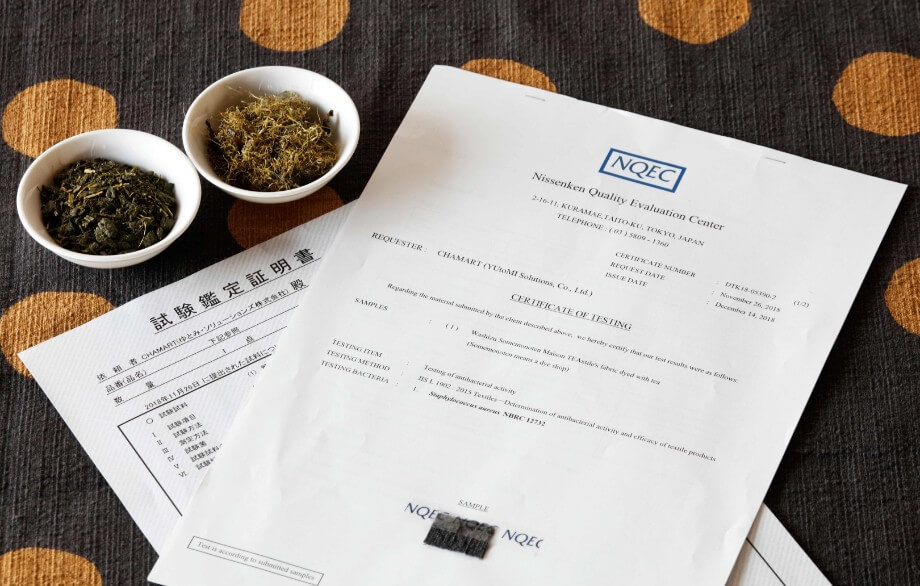
The report of testing antibacterial activity of the cloth dyed with tea dust shows the effect of antibacterial activity.


The dyeing work of Washizu
Washizu: https://www.ochazome-shizuoka-japan.com
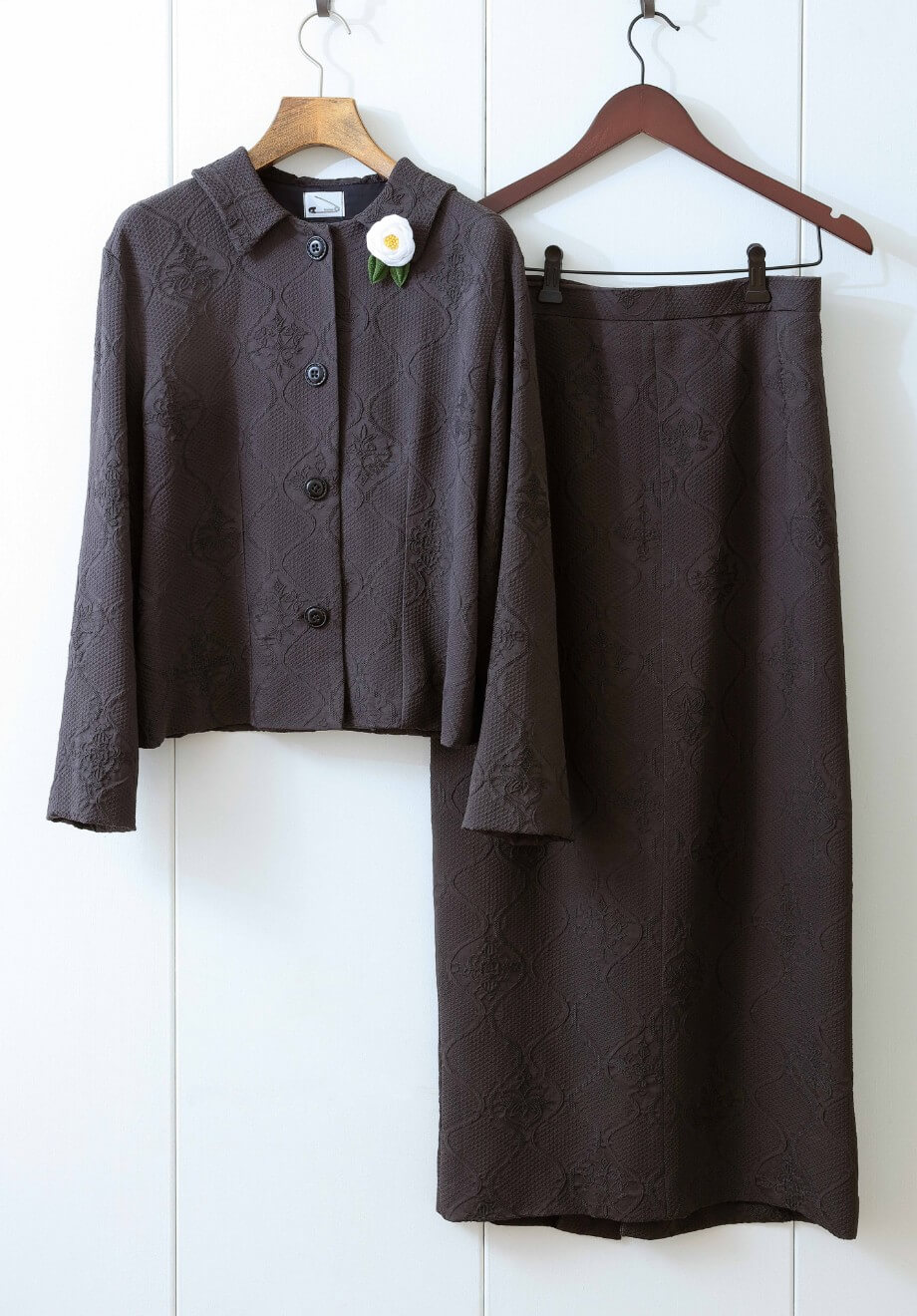
This two‐piece dress was tailored-made by Semi-order Kozue
Semi-order Kozue: https://semiorder-kozue.com
There are two types of green tea, steamed and pan-fired.
The differences between them are, for example, the amount of catechin in brewed tea. The catechin amount in brewed, steamed green tea is larger than in pan-fired green tea.* Catechins have many benefits as mentioned in the above table.
Most Japanese green tea and the teas CHAMART introduces are the steamed type.
*Japan Tea Central Republic Interest Incorporated Association (2013). Cha no kinō, Translated as SCIENTIFIC EVIDENCE FOR THE HEALTH BENEFITS OF GREEN TEA
*Hirofumi Matsuo et al. J-STAGE
「釜炒り茶と煎茶の渋味の解析」Kamairicha to sencha no shibumi no kaiseki (Astringency of Kamairi-cha and Sen-cha)
J-STAGE: https://www.jstage.jst.go.jp/browse/-char/ja
Our site introduces TEAs from around the world,
tea trips, tea museums, tea recipes, and other tea information.
CHAMART is a brand that promotes the concept of “Drink LEAF TEA and Protect Nature,” managed by YUtoMI Solutions Co., Ltd., which was established in 2013 in Shizuoka, Japan.
CHAMART sells various Japanese tea certified as Organic JAS (Japanese Agricultural Standards) overseas as a wholesaler.
Additionally, CHAMART introduces the charms of tea on its site, including tea recipes, tea museums, tea tourism, and more.
For more information about CHAMART, please click on “What is CHAMART” and “Company Profile“.